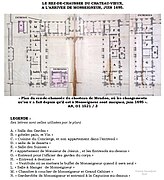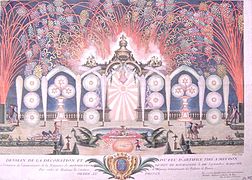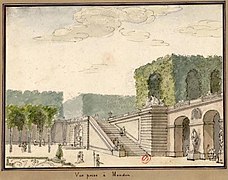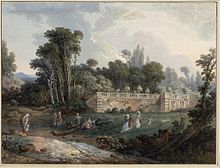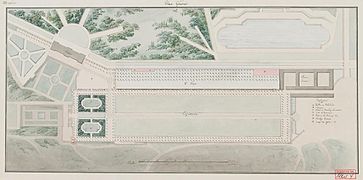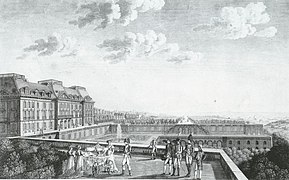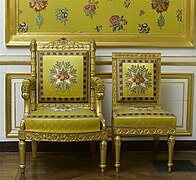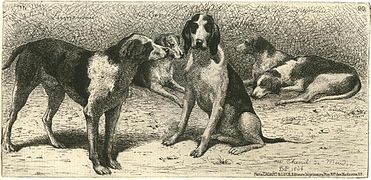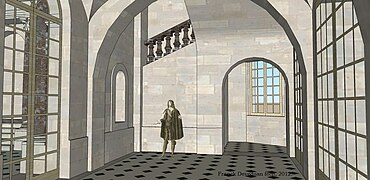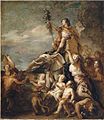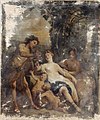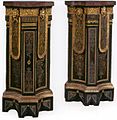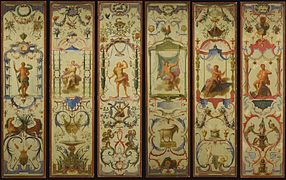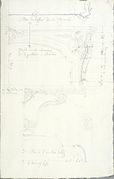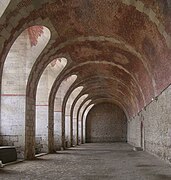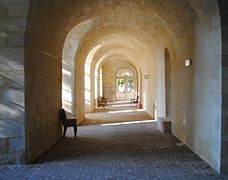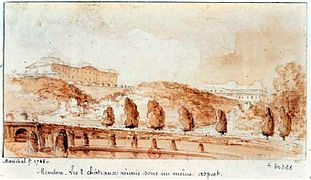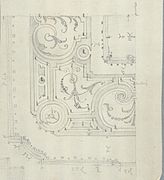Château de Meudon - Château de Meudon
tento článek je drsný překlad z francouzštiny. Může to být generováno počítačem nebo překladačem bez dvojí znalosti. |


Hrad Meudon, známý také jako Královský hrad v Meudon nebo císařský palác v Meudon, je francouzský hrad nacházející se v Meudon v Hauts-de-Seine oddělení. Na okraji zalesněné plošiny nabízí hrad výhled na Paříž a Seina řeky, stejně jako údolí Chalais. Nachází se mezi Paříž a Versailles, v srdci lovecké rezervace, má hrad ideál topografie pro velké zahrady. To mělo mnoho po sobě jdoucích majitelů z renesance až do pádu Druhá francouzská říše. To by nemělo být zaměňováno s Zámek Bellevue, také se nachází v Meudon.
Mezi známé minulé obyvatele patří: Anne de Pisseleu d'Heilly, Vévodkyně z Étampes; kardinál Lorraine, Abel Servien; François Michel Le Tellier Markýz de Louvois a Louis, Grand Dauphin, také známý jako Monseigneur, který propojil Chaville Castle na hrad Meudon. Château-Vieux (Starý hrad) vyhořel v roce 1795 a byl přestavěn na Château-Neuf (Nový hrad), který vyhořel v roce 1871. Uvažovalo se o demolici, ale většina hradu byla zachována a stala se observatoří s astronomický dalekohled v roce 1878 byla připojena k Observatoř v Paříži v roce 1927.
Doména Meudon je od 12. dubna 1972 klasifikována jako historická památka. Hangar Y v parku Chalais-Meudon byl klasifikován jako historická památka od 4. června 2000. Byl to první sklad pro aerostaty na světě a je jedním z mála, kteří stále stojí.
Dějiny
„Existuje několik občanů architektů nebo osvícených cizinců, kteří by si přáli, stejně jako my, aby výdaje vynaložené ve Versailles byly vynaloženy v Meudonu, jako nejkrásnějším místě na světě, a to jak v jeho uspořádání, tak v jeho umístění.“ - J. F. Blondel, Cours d'Architecture ..., 1773, svazek 4, s. 132.

Meudon na konci středověku
Lords of Meudon (1200s-1413)
Existuje jen málo informací o původu hradu, což bylo určitě málo castel | castel. Původní půdorys není znám. Existuje však mnoho záznamů o pánech z 12. století s názvem „Meudon“ a také zmínka o „panství údolí Meudon“ ve 14. století. Marie-Thérèse Herlédan ve své knize zveřejnila popis tohoto období Meudon, Avant le Roy (Meudon Before the King). Mnoho Meudonů zastávalo funkce u soudu, například Robert de Meudon Velký panetier Francie pod králem Filip veletrh. Jeho titul byl zmíněn v listině z roku 1305.
Augustin Isbarre (1413-1425)
17. července 1413 Jean de Montrevel, známý jako poustevník, pán La Faye, komorník krále a manžela Jeanne de Gaillonnel, držitelky hradního léna, prodal hrad se souhlasem své manželky bohatému Augustinovi Isbarre,[1] bankéř a klenotník.[2] V roce 1422 Isbarre, jehož rodina poskytovala finanční služby královské rodině,[3] byl jmenován pohárník krále. Zemřel v Paříži 27. srpna 1425[4] a byl pohřben v Klášter Grands Augustins.
renesance
Rodina Sanguinů a Duchesse d'Étampes (1426-1552)
Léno z Meudon koupil v roce 1426 Guillaume Sanguin, komorník z Karel VII a pokladník vévody z Burgundska. Předtím byl spojován s bývalým majitelem Augustinem Isbarrem, proboštem pařížských obchodníků v letech 1429 až 1431. Zdá se, že na místě starého hradu postavil panství. Zemřel v Paříži dne 14. února 1441.
Jean Sanguin, známý jako "Bastard of Sanguin", zdědil panství jeho otce; zemřel v Paříži 13. listopadu 1468. Měl několik dětí, včetně Antoina Sanguina, který zdědil léno a stal se pánem Meudonu. Antoine se později oženil s Marií Simonovou a zemřel 18. října 1500.
Panství bylo zbořeno roku 1520 Antoine Sanguin, známý jako kardinál de Meudon, syn předchozího kardinála de Meudon, který postavil náměstí corps de logis z cihel a kamene s půdní podlahou nad přízemím se zdobenými světlíky. Byl vyzdoben v italském stylu s pilastry, pásy a rámování kamene. Uspořádání hradu údajně ovlivnilo uspořádání hradu Château du Grand Jardin, v Joinville, majetek rodiny de Guise. Antoine Sanguin dal hrad své neteři Anne z Pisseleu, 5. září 1527. Stala se paní z François I. a téměř de facto královna Francie. Aby se lépe přizpůsobil své paní, François financoval přidání dvou čtvercových pavilonů na obou stranách původního těla a dvou křídel, které končily identickými pavilony. Tato rozšíření odrážejí styl hlavní budovy. Ve stylu Château d'Écouen, uškrcený roh věže byly také přidány do pavilonů. Struktura byla podobná jako u prací prováděných na zámku v Marchais, Aisne, poté ve vlastnictví Nicolase de Longuevala, hraběte z Bossutu a dozorce financí pod vedením Francoise I., guvernéra Champagne a Brie a člena vnitřního kruhu vévodkyně z Étampes. Stejný dosud neznámý architekt musel také vést expanzi Meudona a Marchaise, stejně jako rozšíření sousedního hradu v Sissonne, které jsou všechny ve stejném stylu. Do středu plotové zdi byl také zabudován vítězný oblouk, který sloužil jako majestátní vstup na nádvoří.
František I. z Francie pobýval v Meudonu od 11. července 1537 do 5. srpna. Zůstal tam mnohokrát až do své smrti v roce 1547.
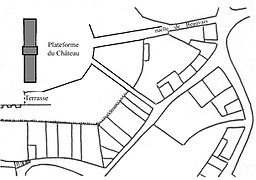
Náčrt vesnice Meudon ukazující umístění hradu Antoine Sanguin kolem roku 1520

Ztvárnění hradu Meudon kolem roku 1520. (budoucí ústřední orgán)

Hrad Meudon, postavený Antoinem Sanguinem kolem roku 1520. Dispozice prvního patra
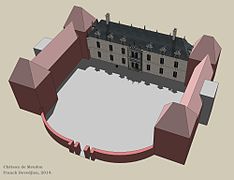
Dodatky Anne z Pisseleu, kolem roku 1540

Pohled na starý hrad v Meudonu z ústí bývalého ruelle de Beauvais. Stav v polovině 16. století

Zámek Marchais, postavený v šestnáctém století, současně s Meudonem a stejným architektem (zámek zachován, majetek Grimaldi rodina Monaka)
Kardinál Lorraine a de Guises (1552-1654)
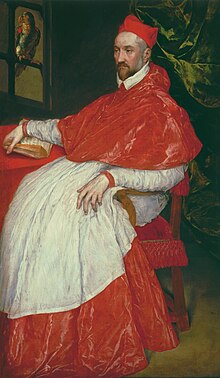

Po smrti Františka I. musela Anne de Pisseleu, pak v nemilosti, prodat panství Meudon v roce 1552 Charles de Guise, Kardinál Lorraine.[5] Tím skončila přítomnost sanguinů v Meudonu, která trvala více než sto let. Bývalý favorit se stáhl do Château d'Heilly, kde zemřela v září 1580.
Kardinál poté zrekonstruoval rezidenci a inspiroval se italským architektonickým stylem, který objevil během svých cest do Říma. Dopis napsaný 28. prosince 1552 adresovaný jeho švagrové Anne d'Este uvádí: „Byl jsem v Meudonu, když jsem byl v Paříži, a prosím vás, abyste se ujistili, že dům je dokončen .. . žádné krásnější domy v tomto království ... "

Kardinál měl křídla na straně nádvoří galerie převyšované terasou, podle výkresů Francesco Primaticcio. Interiéry byly zdobeny výjevy z Tridentský koncil, kterého se kardinál aktivně účastnil, pravděpodobně ve stylu toho, co se současně stalo v Itálii Taddeo a Federigo Zuccaro. Řadové zahrady a oranžerie byly vytvořeny kolem malých budov, včetně malého fantasy paláce věnovaného víly a múzy, slavná „Meudonova jeskyně“, vycházející také z kreseb Primaticcia z let 1552 až 1560 a zdobená skladbami umělce. Tvoří malý palác pod platformou arkád, chráněný před výhledem kopcem, který ho vizuálně odděluje od hradu, jak je znázorněno na tisku Izrael Silvestre představující jeskyni. Ten druhý je ve skutečnosti tvořen třemi pavilony opírajícími se o svah, kde se mísí italský a francouzský styl. Centrální pavilon kryl vlastní jeskyni zdobenou mozaikami, mušlemi, korály a maiolica, a jehož hlavním dodavatelem byl sám Primaticcio. V prvním patře centrálního pavilonu byly ve velkém salonu vystaveny starožitnosti. Historik Henri Sauval napsal, že Diana z Versailles byl přivezen z Itálie a umístěn do zámku Meudon, ale zdá se, že nedávný výzkum dokazuje opak.[6] Tato jeskyně měla okamžitý úspěch a byla chválena Pierre de Ronsard v jeho „Chant pastoral sur les noces de Charles, duc de Lorraine et Madame Claude, fille du roi“ (Pastorální píseň o svatbě Karla, vévody z Lorraine a madame Claude, dcery krále).[7]
V roce 1568 Giorgio Vasari byl nadšen jeskyní, jejíž pověst sahala až do Itálie: „V Meudonu, pro lotrinského kardinála, provedl Primaticcio mnoho dekorací ve svém velkém paláci zvaném La Grotte, s tak mimořádnou amplitudou, že připomíná antické lázně, kvůli nekonečnému počtu a velikosti jeho galerií, schodišť, veřejných a soukromých bytů. Stavba této jeskyně byla rozložena v průběhu času, počínaje stavbou samotné jeskyně a dvou ramp schodiště (kolem 1552-1555 ) a poté ve druhé fázi dva pavilony (1559). Dolní kryptoportico pak byla postavena ve třetí fázi.

Po smrti lotrinského kardinála v roce 1574 zůstal hrad majetkem rodu Guise, jehož byl spolu s hradem z léna jedním z lén. Joinville, Haute-Marne.
Meudon byl vypleněn během Války náboženství. A právě v Meudonu se budoucí Henri IV (Henry IV) dozvěděl o atentátu na Henry III Francie dne 1. srpna 1589 od Jacques Clément. Téhož dne se Henry z Navarry vydal navštívit zraněného krále Saint-Cloud. Král ho ujistil o svém zdravotním stavu. Henri se vrátil k Meudonovi. Maximilien de Bethune, vévoda ze Sully, který ho doprovázel, se ubytoval v domě „Sauvat“ ve vesnici. Následujícího dne se stav krále zhoršil a on zemřel v Saint-Cloud. Henry of Navarre se stal francouzským králem, prvním králem Bourbonů.
Henri de Guise sotva měl čas navštívit Meudon. Byl zavražděn v roce 1588. Meudon se stal jedním ze sídel Ligy. 24. července 1605 se uzavřelo manželství Francois de Bourbon, princ z Conti (1558-1614) ženatý Louise Marguerite de Lorraine v kapli zámku. V roce 1618 vévoda Lotrinský pověřil svého architekta, Gabriel Soulignac, s úpravou hradu a rozšířením zahrad.[8] Další práce provedl Soulignac v roce 1623 s výstavbou terasy a schodiště poblíž jeskyně.
V roce 1639 se Jacques Dubreuil chlubil Meudonovými schody a věžičkami: „Zahrada je středně velká, vyrobená z květinových záhonů, hranic, otevřených uliček, obklopená uličkami pokrytými krásnými stromy a balustery.“ V roce 1641 malíř Nicolas Poussin navštívil Meudon, bezpochyby přitahovaný slavnou výzdobou Primaticcio. Především dne 18. Května 1643 došlo k sjednocení Gaston d'Orléans, bratr Ludvík XIII s Marguerite of Lorraine, byl obnoven v kapli hradu s požehnáním pařížského arcibiskupa.
Doména byla vypleněna pod Politická strana, protože lotrinští princové, kteří vlastnili Meudon, se postavili na stranu vzpoury proti královské autoritě. Počínaje rokem 1649 tedy Grand Condé, v čele královské armády, chytil Charenton, Saint-Denis, Saint-Cloud a Meudon.
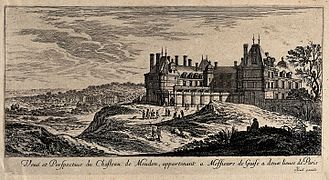
Pohled na hrad Meudon kolem roku 1600. Ve skutečnosti vesnice Meudon couvala ke kódující zdi
Jeskyně Meudon, Izraelem Silvestrem, první polovinou sedmnáctého století

Jeskyně Meudon, podle Claude Chastillon, asi 1600
Grand Siècle
Abel Servien a markýz de Sablé (1654-1679)
Meudon ve špatném stavu poté koupil 12. září 1654 Abel Servien, Dozorce financí, který získal titul barona de Meudon. Jakmile byl nákup proveden, Servien nechal provést rozsáhlou rekonstrukční práci architekta Louis Le Vau. Byl na vrcholu své kariéry a cítil, že by Meudon měl tuto sílu odrážet. V Paříži žil Servien v Hôtel de la Roche-Guyon poblíž Palais-Royal minimálně od roku 1651 do roku 1659. Hrad byl poté bohatě zařízen a vyzdoben. Střední předek byl nahrazen osmibokým pavilonem, převyšujícím vysokou střechou ve tvaru komolé pyramidy. Uprostřed pavilonu bylo velké dvojité točité schodiště. Předchází mu velké schodiště zdobené dvanácti sloupy mramorových monolitů. V prvním patře byl velký kupolovitý salon, otevírající se do zahrad, podobný tomu, který v té době stavěl Nicholas Fouquet na zámku v Vaux-le-Vicomte. Byl dozorcem financí u Servien a pod vedením Servien, který byl starší než on. Servien nechal v předhradí postavit velkou terasu, aby vyčistil výhled na hrad, čímž pohltil téměř třetinu vesnice Meudon, kterou přesunul jinam.
Na straně zahrady postavil monumentální oranžérii, která se dochovala dodnes. Rozšířil park, který existoval přinejmenším od vévodkyně z Étampes. Prostřednictvím mnoha výkupů půdy se mu podařilo prosadit „Velkou perspektivu“ jižně od hradu, kde byly nádrže a rybníky, včetně Chalais. Patent na dopisy ze dne 31. srpna 1657 nést „povolení rozšířit park Meudon, uzavřít jej do zdí, přestože získaná dědictví jsou v sousedství potěšení Jeho Veličenstva“, jinými slovy sousedního Palác ve Versailles.
Když královna Christine Švédska přijela do Francie, nabídla Servien bronz Adrian de Vries, Psychologie únosů rtuti, nyní v Louvru.[9] Servien nechal tento bronz umístit na konec záhonu, těsně nad jeho nový oranžerie.
Servien zemřel 17. února 1659 v samotném Meudonu ve svém bytě v přízemí poté, co utratil skutečné jmění za Meudon, stále ve výstavbě.
Jeho syn, Louis-François Servien, markýz z Sablé, ochránce Jean de La Fontaine, udržoval panství dvacet let. 2. srpna 1665 Gian Lorenzo Bernini navštívil Meudon.
Finanční omezení nakonec donutilo Louis-Francoise Serviena prodat Meudon François Lemoine de Louvois v roce 1679. Již o rok dříve, v roce 1678, byli členové Académie Royale d'Architecture navštívil Meudon a zjistil, že „to, co bylo za dnů M. Servien zrekonstruováno na straně zahrady, je velmi zničené, zejména římsa centrálního pavilonu “. (P.V.I. 193).
Zámek po smrti Ábela Serviena v roce 1659
Parter Meudon a socha "Merkur a psychika", asi 1660.

Merkur a psychika, bronz od Adrien de Vries.

Jeskyně ve státě, kde ji našel Servien v roce 1654, po problémech Politická strana.
Ramena rodiny Servienů.
Uspořádání prvního patra starého hradu po smrti Servien, 1659.
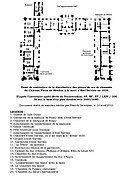
Uspořádání přízemí starého hradu po smrti Servien, 1659.
Náčrt vchodu do hradu a vesnice v roce 1654, před vytvořením Velké terasy. (Marie-Thérèse Herlédan, Bulletin des Amis de Meudon).
Schéma ukazující vývoj Meudonu pod Abelem Servienem.
Nedokončený projekt od Louis Le Vau pro centrální pavilon Vieux-Château. Asi 1655.
Louvois a jeho manželka Anne de Souvré (1679-1695)


Pro mocného ministra, který si v mládí říkal „M. de Chaville“, bylo místo Meudon ideální, poblíž Versailles i zámku Chaville, kde se rodinný majetek nacházel. Byl přestavěn jeho otcem, Michel Le Tellier. Louvois získal vrchní dozor nad budovami v roce 1683, poté se pustil do řady velkolepých přeskupení. Fasádu zámku obohatil o busty a balkony na sloupech ze šedého mramoru. Přepychově vyzdobil celý interiér. Dřevo nechal instalovat v roce 1684. Nad dveřmi byly květinové obrazy ve stylu Jean-Baptiste Monnoyer. Kabinet zobrazoval miniatury Versailleských hájů namalovaných Jeanem Cotellem starším, bezpochyby dárek Ludvíka XIV. V roce 1688, který měl poděkovat jeho ministrovi za dokonalé dokončení mramoru Trianon de porcelaine. Velká galerie, která zabírá celé pravé křídlo v prvním patře, zdobí dvanáct obrazů od Adam Frans van der Meulen o velkých bitvách vlády.
Nicodemus Tessin mladší během své návštěvy hradu v roce 1687 poznamenal toto: „V Meudonu jsem jel s gentlemanem z Gasconu (který čerpal všechny pohledy na starověký Egypt, jménem M. Le Cas) as M. Silvestrem ... Nejpozoruhodnější v r. dům byl strop malovaný oleji přímo na klenbě M. de La Fosse. Ve čtyřech rozích kompozice, simulující štuk, byly namalovány dvě sedící postavy a dvě stojící postavy: v rozích a mezi sochami strop byl namalován v olejích přímo na trezor pomocí Charles de La Fosse. V rozích a mezi sochami bylo něco jako oeil-de-boeuf, skrz které bylo vidět oblohu. Vedle postav a aby vynikly o to lépe, bohaté koberce různých barev a mezi prvním a druhým rohem velké ovály, ve středu kterých byly vyobrazeny Pandora. Vedle nich Rtuť byl obzvláště dobře malovaný. Klenba se táhla přes svršek římsa a stín níže udělal velmi dobrý efekt. Velký štuk listely všude kolem byly úplně pozlacené. Přilehlou místnost musel také vymalovat M. de La Fosse. Nahoře, v oválné místnosti, udělaly zrcadla velmi dobrý dojem. Byly uspořádány kruhově a byly vysoké jako pět oken. Byla tam jen polovina dřeva. V každém panelu byly umístěny tři ledové pláty, asi 6 qv. Vysoko, a když jste byli ve středu panelu, mohli jste se vidět ve třech oknech najednou. Galerie byla pěkně vyzdobena několika stoly jaspisu, bustami atd. A všechny královské akce měly být namalovány Van der Meulen; Dva už byly hotové. Na jednom konci galerie byl salonek, ve kterém byl stůl a celý panel mezi oběma okny obložen zrcadlovým sklem a otevírání dveří bylo tak velké, že daleko bylo téměř vidět celý galerie. Kromě toho existuje spousta krásných, velmi velkých zrcadel. Nábytek byl velmi jemný, ale neměl zvláštní vkus. Všechny zimy jsou odstraněny kvůli půdní vlhkosti. Dole ve vlastní místnosti M. de Louvois byly tři měděné trubky, které umožňovaly průchod tepla podle libosti. Toto teplo pocházelo z měděných kamen umístěných v komíně sousední místnosti. K tomuto komínu dorazila ventilační trubka procházející pod vestibulem a poté rozdělila teplo, když se otevřelo okno této komory (jako „stroj na výrobu tepla“ ve Versailles).
Dům, který je z jedné strany stáje nesen pilíři z kamenů nebo pilířů, je zvenčí ve velmi špatném stavu. Stránka je členitá na možné, ale přesto velmi příjemné. Střední ulička dole v zahradě před terasami je pokryta trávníkem a široká 70 metrů; Pak uprostřed aleje písku o šířce osmi metrů jsou smrky a jiné stromy; Potom ze dvou stran nový trávník o devíti metrech a opět písečná alej se stromy širokými osm metrů. Parter M. Le Nostre, uprostřed, před jeskyní, kterou jsem nakreslil, je velmi pěkná, takže dvě „výšivky“ ve středu před domem, se dvěma mramorovými vázami a mramorovými sochami kolem oválné pánve, ručně vyráběné jako dlaždice neudělaly špatný efekt. Také jsem tam nakreslil krabice oranžových stromů a vzal je zvlášť. Tato zahrada je stejně jako park obklopena zdí nejméně sedm mil po obvodu. Ve spodní části zahrady byl další velký rekreační dům, který M. de Louvois koupil na celý život pro M. Honoré Courtin Courtin.
Venku měl Louvois rozsáhlé hydraulické práce, které poháněly vodní cesty v parku a umožňovaly nejpozoruhodnější vodní trysky. Horní park byl vyvinut, zatímco Le Notre během 80. let 16. století nepřetržitě pracoval na zahradách a vytvářel prakticky všechny spodní zahrady, vymýšlel nové háje a parter, včetně před Grotto. Louvois také uspořádal velkou zeleninovou zahradu podél avenue hradu, aby vyhověl potřebám hradu, zeleninovou zahradu, která se později nazvala „zeleninová zahrada Dauphina“. Stručně řečeno, staví v Meudonu vše, co Louis XIV dělal ještě efektnějším způsobem, a to ve Versailles současně. A zeptal se Izrael Silvestre, mistr kreslení z Louis de France vyrýt celé panství, které Silvestre provedl několika velmi působivými tisky, mezi nejopatrnější díla.


V červenci 1681, francouzská královna, Maria Theresa of Austria (1638-1683), přišel navštívit Meudon, kde „pan de Louvoy měl tu čest sloužit jí“ (d Po „Mercure Galant“ v červenci 1681.) 17. srpna 1684 měl Louvois pro Meudona připraven velký svátek na počest Filip Orleanský (1640-1701). Král a jeho manželka, majitelé sousedního hradu Saint-Cloud, zejména 2. července 1685, Louis XIV, Louis de France Dauphin, Dauphine, Monsieur a Madame, „doprovázejí větší část knížat a pánů dvora“, přicházejí do Meudonu, kde Louvois zachází s králem a celým dvorem „Velkolepě.“ Bylo mu dáno „velkolepé shromáždění , během níž všechny housle a hoboje opery hrály melodie od Jean-Baptiste Lully „(...)„ Ale M. de Louvo Bylo mu líto, když viděl, že je potěšen po celou dobu, kdy s ním král byl. “V roce 1686 je stále přijímán Meudon na počest siamských vyslanců, kteří objevil zahrady i zámek. Louvois nebyl přítomen, aby je přijal, protože byl u Maintenon a Král, aby sledovali práce na kanálu Eure. 25. srpna 1689 Louvois znovu přijal Filipa Orleánského (1640-1701) na večeři v Meudonu. 29. června 1691, dva týdny před náhlou smrtí Louvoise, „Monseigneur šel do Meudonu s paní princeznou de Conti; udělali si občerstvení na zámku a dlouho procházeli parkem a zahradami“ (Dangeau).
16. července 1691 Louvois náhle zemřel ve Versailles. Dosáhl bodu vyznamenání a nádhera Meudona hmotně symbolizovala tuto moc.
Na návrh Ludvíka XIV., Vdovy po Louvoisovi, Anne Souvré a jeho syn Barbézieux souhlasil s výměnou Meudona za Chateau de Choisy a rovnováhu. Ve vzpomínkách markýze de Dangeau ve středu 1. června 1695: „Král ráno navrhl M. de Barbezieuxovi výměnu Choisy s Meudonem; zeptal se jí, kolik si Madame de Louvois vzala Meudon na svůj podíl ; M. de Barbezieux mu řekla, že ho vzala za jednotku 500 000 franků; Král mu řekl, že mu dá 400 000 z jeho návratu, a Choisy, kterého počítal za 100 000 franků, pokud to bylo pro madam de Louvois; Že mu přikázal, aby se o ní šel dozvědět, ale že ji nepožádal o žádné uspokojení; Že si přeje, aby s ním zacházela jako se soukromou osobou, a aby myslela jen na jeho zájmy. M. de Barbezieux odešel do Paříže, aby našel matku, kterou králova nabídka potěšila a ke které se výměna dobře hodí. Smlouva bude podepsána první den; o podnikání jsme začali mluvit až ráno a bylo to hotové večer." Hrad, jehož hodnota byla 500 000 livrů, a který již byl značně zkrášlen následnými majiteli, znal své nejskvělejší období.




Pohled na vchod do zámku Meudon, Israël Silvestre, 1685
Zadní část nádvoří Château-Vieux. Kolem 1685-1690. Bibliothèque Mazarine, ms 3361
Fasáda parterové strany Château-Vieux. Kolem 1685-1690. Bibliothèque Mazarine, ms 3361
Uspořádání přízemí Meudon po smrti Louvois, 1695
Uspořádání prvního patra Château-Vieux po smrti Louvois, 1695
Louvois chassant à Meudon (lov Louvoisů v Meudonu), c. 1683. Musée de Versailles

Grande Perspective de Meudon, Israël Silvestre, třetí čtvrtina 17. století, Musée d'art et d'histoire de Meudon
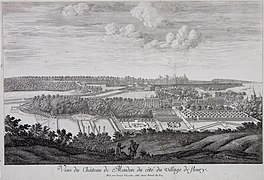
Vue du Château de Meudon du Côté du Village de Fleury. (Pohled na zámek de Meudon z vesnice Fleury), Izrael Silvestre, 1688. Musée d'art et d'histoire de Meudon
Apogee: Louis XIV and Monseigneur (1695-1711)



Díla prince


The Grand Dauphin udělal rozsáhlou práci v Meudonovi a přeměnil ji na své speciální výstaviště, kde utratil částku jednoho milionu sto čtyřicet tisíc Francouzské livres, ačkoli král jeho otec to dal mezi královská sídla a na starosti Bâtiments du Roi.[10] Během šestnácti let byly na zkrášlení a údržbu statku vynaloženy nejméně tři miliony životů, což je kolosální suma. Princ vyzdobil byty podle svých představ. Dauphin dovolil Meudonovi vyjádřit své vlastní umělecké koncepce, rozbíjející se s někdy kompasovaným aspektem stylu Ludvíka XIV. I když to nebylo poprvé, Meudon systematicky používal dřevo „Capucine“, vyřezávané a lakované pásy dřeva s pozlacenými akcenty. Regency styl částečně se projevil u Meudona. Dauphin tam shromáždil své bohaté sbírky, které se pokoušely konkurovat královským sbírkám: achát vázy, indické látky, Gobelín gobelíny, čínské porcelán, obrazy velkých mistrů a zejména jeho sbírka drahokamů. Neváhal několikrát vyzdobit některé místnosti a odstranit například natřený strop Charles de La Fosse dát výraz světlu stylu Claude Audran. Jeho hlavní byt se nacházel po celé délce přízemí ve východním křídle Château-Vieux. Měl také průvodní byt v Château-Neuf, stejně jako „malý nový byt“ v křídle kaštanového stromu.
Dauphin se rád obklopil v Meudonu se svou rodinou, svými přáteli a soudci, zejména Marie-Adelaide ze Savoye vévodkyně Burgundska, Marie-Anne z Bourbonu (1666-1739), jeho snacha, princezna z Conti, a Louise Francoise de Bourbon, vévodkyně z Bourbonu, (1673-1743)]], její dvě nevlastní sestry, Louis-Antoine de Pardaillan de Gondrin D'Antin syn madame de Montespan. Také ubytoval svou milenku, Marie-Émilie de Joly de Choin. Jako jeho otec na Castle of Marly Dauphin rád nalezl v Meudonu uvolněnou a vřelou atmosféru s vybranými společníky. Aby se Dauphin přizpůsobil tomuto četnému doprovodu, provedl rozsáhlé doplňky. V roce 1702 se prostor v Château-Vieux brzy ukázal jako nedostatečný. Měl křídlo kaštanu, bývalé nádvoří kanceláře, předělaný tak, aby jej bylo možné připojit k zámku pomocí závěsné galerie. Zařídil velkou přijímací halu v přízemí. Postavil také nové commons, které jsou stále viditelné. Svěřil se Jules Hardouin-Mansart, architekt všech těchto prací, stavba kaple. Antoine Coypel, jeden z oblíbených malířů Dauphina, namaloval oltářní obrazy, „Vzkříšení“, monumentální obraz a „Zvěstování“, mnohem menší velikosti. Sochy realizuje Noël Jouvenet, François Lespingola a Jean Hardy.
V roce 1705 stále chyběl prostor pro ubytování dvořanů, stále více a více. Monseigneur se každou smrtí stárnoucího Ludvíka XIV. Může stát dalším francouzským králem. Dauphin se poté rozhodl demolovat jeskyni, která vyšla z módy, a postavit nový hrad, Château-Neuf . Na projektu, který byl svěřen dodavatelům kaple a paláce ve Versailles, spolupracovali Jules Hardouin-Mansart a Louis XIV. Veškerou práci v Meudonu skutečně provedli stejní umělci zaměstnáni králem, kteří pracovali pro instituci královských budov.
Château-Neuf měl pět úrovní, ale kvůli strmému svahu neměl stejný vzhled na straně parter jako na straně lesa. Skládalo se ze tří pavilonů korunovaných střechami s hřebenovou terasou, propojených křídly budovy. Tato střízlivá architektura, která neměla zastínit architektonický charakter sousedního Château-Vieux, byla přesto obohacena o jemné sochy na bočních pavilonech a centrální štíty, kde andělé drží erb Dauphin. Uvnitř se řada bytů otevírala do velké centrální chodby. Vnitřní výzdoba, která zdůrazňovala sbírky Dauphin, byla složena ze dřevěných panelů lakovaných nebo malovaných v barvách patel, vylepšených zlacením. Pro Monseigneura byl naplánován obřadní byt, protože Ludvík XIV si navzdory nové výstavbě zachoval obvyklé ubytování v Château-Vieux. Château-Neuf byl obdivem celé Evropy. Napodobil ji asi o deset let později Vévoda z Antinu na Hrad Petit-Bourg v Evry.[11]

Uspořádání přízemí Château-Vieux v roce 1695, při příjezdu Monseigneura.
Uspořádání přízemí Château-Vieux v roce 1700.
Uspořádání prvního patra Château-Vieux v Meudonu, 1700
Výřez z Château-Vieux, s kaplí, po roce 1702. Osa východ-západ, 2013
Schéma Château-Vieux a aile des marronniers (křídlo kaštanového stromu) vpravo. ADY

Château-Neuf na straně parter. Mariette, kolem roku 1715.

Schéma třetí úrovně Château-Neuf (známé jako „le Bel étage“, krásná podlaha), od Mariette, kolem roku 1715
Bohatství visících zahrad

Zahrady neměly být překonány. Báseň s názvem Maison Royale de Meudon (Royal House of Meudon) ze dne 1703, dokonce je porovnal s Visuté zahrady v Babylonu z Semiramis. To expand Meudon, the Dauphin in 1696 acquired the neighboring estate of Chaville. He thus formed a vast hunting preserve where he and his father, who also liked Meudon, practiced venery. The park of Meudon was thus linked to that of Versailles, and together they made up the Grand Parc de Versailles, extending from Meudon to Saint-Germain-en-Laye. Many embellishments are carried out in the gardens. Louis XIV took pleasure in advising his son on them. The King - or his son - even drew up a "Manière de montrer Meudon" a guide in the style of the texts written for Versailles.
The Arthelon waterfall, lower gaardens of Meudon. Ca. 1700
one of the two waterfalls framing the "pièce de M. Le Nostre" (piece by Monsieur Le Nostre)[Citace je zapotřebí ]
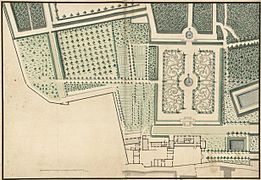
Plan for renovation of the parter of the Hôtel Courtin, lower gardens of Meudon, ca 1710. BNF

The park and the gardens of the château, Mariette, circa 1715

Overall map of the domains of Meudon and Chaville, by Alexandre Lemoine, ADY. 1723
18. století

At the death of the Dauphin in 1711, the castle was still perfectly maintained, since the Bâtiments du Roi (King's Buildings) administered it. Nevertheless, until the death of Louis XIV, no member of the royal family returned to Meudon, as a result of the remarks made by Louis XIV the day after the death of Monseigneur his son, wishing that the new Dauphin, the Duke of Burgundy, make no more trips to Meudon. The Marquis de Sourches, on the 17th of April, 1711, notes that "Meudon was completely emptied and that all the furnishings were taken to the King's furniture storehouse."ref>Mémoires du marquis de Sourches, 17 avril 1711..
On 17 May 1717, the Tsar Petra Velikého, doprovázeno Prince Rakoczy a Marshal de Tessé visited Meudon and rode horseback in the gardens.[12]
On May 16, 1718, Madame de Ventadour organized a fireworks show for Louis XV, who visited Meudon two or three times a week all that summer. On the following June 6, a new fireworks display was mounted in honor of the king.
Duchess of Berry, daughter of the Regent (1718-1719)

Marie Louise Élisabeth d'Orléans, Duchess of Berry, eldest daughter of the Regent, owned the Château d'Amboise and wanted to swap it for Meudon. She was then the first lady of the court of France, and both cousin and aunt to the young unmarried king. The Regent eventually agreed to the exchange effective 30 October 1718. The Duchess of Berry, who was then pregnant, gave the management of this new residence to her paramour, the Count of Riom, lieutenant of her guards.[13] Riom took possession of the castle the next day, 31 October. But the governor in office, Hyacinthe de Gauréault Dumont nevertheless retained his salary. On 2 November 1718, the Duchess went to Meudon to choose her apartments. On 8 February and 24 March 1719, the Regent came to Meudon to have supper with his beloved daughter, by then just about to give birth.[14]
From April 12 to May 14, 1719, the duchess was convalescing at Meudon, hoping to recover from her harrowing delivery. She died on July 21, 1719, at her Château de la Muette in Paris, to she had travelled from Meudon.[15] On 22 July 1719, a few hours after her death, seals were affixed to her properties: the Luxembourg palace and her castles of La Muette and Meudon.
Saint-Simon (1719-1722)
After the death of his daughter, Regent made Meudon available in favor of Saint-Simon one of his principal advisers, a considerable honor. Thus, the famous memorialist could stay close to Saint-Cloud, where the Regent owned his family castle. On the night of June 15–16, 1722, the marriage of the daughter of Saint-Simon, Charlotte of Saint-Simon, with the Prince de Chimay was celebrated at the chateau. The blessing was given by the Abbé Languet de Gercy, parish priest of Saint-Sulpice.
Louis XV and his children


Le 27 septembre 1722, à la demande du jeune roi, le Maréchal de Villars vient à Meudon voir le fortin construit pour Louis XV, qui « lui parla souvent de son fort et le mena à toutes les attaques ». Rappelons que Louis XV était petit-fils de Monseigneur.

On the 17th of April, 1723, the King went to Meudon, went through the apartments of the Chateau, and gave some orders for the stay which his Majesty was to go there to do. Indeed, from 4 June to 13 August 1723, Louis XV, the "Infante Reine", the Regent and the Court settled in Meudon for a month, time enough to restore Versailles to house the young sovereigns. 10. srpna Cardinal William Dubois died at Versailles. "As soon as he was dead, the Duke of Orleans returned to Meudon to inform the King of this news, who begged him to take charge of all the conduct of affairs, declared him Prime Minister, and was sworn in on the following day" . Pierre-Denis Martin (1663-1742) painted for the king "A vision of Meudon in perspective that includes all the park and the castle, Monseigneur entering there."
On December 14, 1725, the new queen Marie Leszczynska, who married Louis XV on September 4, came to visit Meudon for the first time.
Finally, in September 1726, a royal edict brought together Meudon at the Crown Estate with the land that depended on it, with the exception of Chaville Castle and Park, and Castle and farm of Villacoublay. On this occasion, the arms of Le Tellier - azure, with three lizards of silver laid in pal, to the chief sewn Gules charged with three gold stars - which were still in place within the central pediment, are erased.
In May 1733, at Versailles, a scene was set up between Louis XV and the governor of the castle of Meudon: Marquis de Pellevé,
"Stay of the Children of France in Meudon in 1733.
The sojourn of the children of France at Meudon was decided at the beginning of May, 1733, in an assembly of doctors held in Versailles, with regard to their health, the death of Madame The Duke of Anjou having frightened the others.
Their journey was subsequently scheduled for the 21st of the same month and a few days before De Pellevé, Governor of this castle, speaking of their stay with M. le Cardinal de Fleury, told him that it would cause him some expense, and that he was persuaded that his Eminence wished And to treat him like his predecessor M. Hyacinthe de Gauréault Dumont had been there while the feu Roy remained there, and to grant him the same gratification.
The cardinal replied that the king's affairs were not in a position to make such graces, which did not prevent him from taking the time that the cardinal was with the king to speak to him in the presence of His Majesty and His Eminence told him the same thing.
He did not confine himself to these two rejections, he made the same request on the 21st, at the time when his Majesty was speaking to the duke Of Charot. The King replied that the matter was decided, which obliged him to cease. Only for a few moments: for he has again returned to the charge, and has represented to the King that he has interrupted a second time, the expense which he would be obliged to make, and the injustice which was done to him, His Majesty to tell the captain of his guards to take him out of his room. It was ordered to the officer of the guards who commanded Meudon not to let him enter the chamber of the Louis de France (1729-1765) or the ladies".
Queen's parents: the visit of Stanislas Leszczyński (1736-1737)

4. června 1736 Stanislas Leszczyński, after abdicating in April, temporarily settled in Meudon. "SM goes there at least once a week since the king and queen of Poland live there."[16] (Vévoda z Luynes ).
On September 30, 1736, King Stanislas secretly signed the Declaration of Meudon[17] under pressure from Louis XV and the Cardinal Fleury. According to the terms of the agreement, possession of the Vévodství Bar would be "current" for the former Polish king and "possible" for Louis XV.
On January 18, 1737, Leszczyński handed the seals to the new Chancellor, who swore an oath to the King of Poland. The ceremony took place in the large vestibule of the Château Vieux, on the ground floor of the central pavilion. Obraz od François-André Vincent of this ceremony, is from much later, since it dates only from 1778.
On March 31, 1737, "the king went today to Meudon bid farewell to the king and královna Polska. (Vévoda z Luynes ). They left Meudon the next day, April 1st. The two castles were then stripped of their furnishings.
In the summer of 1743, facing the threat of Charles Alexander, Queen Kateřina of Poland, wife of Stanislas and mother of the French queen, took refuge in Meudon. Stanislas took refuge in Metz.

The Knight of Fréjus visited Meudon on May 5, 1748. He left the following description:" On the 5th of May 1748, the first Sunday of the month, I went to Meudon by galiot. We went up to Sèvres and from Sèvres we went upriver to the Kapucín monastery at Meudon, where we heard mass. The church there is not unusual, but their garden is very beautiful. From there we ascended the terrace of Meudon to the château, which is situated on a mountain from which all of Paříž and the surrounding villages can be viewed. All the hills around Meudon are planted in vineyards and well maintained. The castle is superb. I noticed on the large door the arms of Louvois, and below the image of Louis XIV v kovu. A gallery reigns in beauty outside the windows of this castle, as well as a facade on the side of the garden, charming. Švýcar[je zapotřebí objasnění ] then took me to the apartments, which are very beautiful, though less extensive than those of the Palace of Versailles. I saw two chambers lined in Gobelíny tapestry of admirable beauty.
Most rooms are covered in mirrors. The gallery leading to the chapel is superb. I saw there a very fine picture of the siege of Mannheim under Louis XIV, and a bust of Alexander of porfyr which is inestimable. Another, of Aristoteles in Egyptian marble, is seen as a masterpiece. The chapel of the castle is very agreeable, with a single loď. There is only one altar, whose painting represents the resurrection of our Lord Jesus Christ, but it is one of the most beautiful pictures that can be seen, and is said to be of Raphael by Antoine Coypel. From the castle we were led to see the new apartment [the Château-Neuf] It is very lovely and very agreeable, but less handsome than the first. From the castles to the village which is at the foot of the mountain, one sees only parterres and gardens of a charming cleanliness and arrangement. We saw the orangeries, the greenhouses. They are far from being as beautiful as those of Versailles. From there we ascended by a superb staircase to the top of the mountain, where you find the most beautiful alleys of trees, with beautiful pools of water. Going through the woods on the side of Sèvres, you find a basin of prodigious expanse, at the top of the mountain, beside a green meadow with a very gracious view. The alleys and gardens of Meudon have no beautiful statues as at the park at Versailles. The castles themselves do not approach the richness of that of Versailles but the location of Meudon...provides a beautiful view...The stables there are not beautiful. After seeing all that there was to see, we were dined at Meudon in the village... For dinner for three, including me, I paid three livres... [I] have not eaten elsewhere pigeons so fat (...)[18]
Château de Bellevue preferred after 1750
Jako dospělý Louis XV preferred the Château de Bellevue â that he had built for Madame de Pompadour. The castle was used to accommodate courtiers, and the castle stables are used to serve Bellevue, whose stables were very small.
View of Meudon from Fleury. Jacques Rigaud, ca. 1730-40
"Dessein de la décoration et du feu d'artifice tiré à Meudon" (Drawing of decorations and fireworks at Meudon) in honor of the Duke of Burgundy, 13 September 1756. AD 92.
West wing of the Château-Vieux de Meudon, 1773. Drawing by architect Louis Le Dreux de La Châtre
"Vue prise à Meudon" (View from Meudon): the stair of the Petit Pont. Late 18th century by Thiery de Sainte-Colombe, INHA
Louis XVI and Marie-Antoinette in Meudon
The new young king often liked to come and hunt in Meudon. One year after his accession, the architect Louis Le Dreux de la Châtre drew up an inventory dated October 10, 1775, which enumerates the "mirrors, marbles, paintings and other effects belonging to the King" in the castle. In the margin are drawn overall diagrams of all the mirrors.[19]
An edict of the king, in May 1778, united the domain of Meudon to that of Versailles, "to be governed and administered in the future in the same manner."
Louis XVI himself designed a pavilion called the "Trivaux Pavilion" in 1783, in an Anglo-Chinese style, which was finally corrected in a more French style by the architect Jean-François Heurtier. This pavilion was situated at the very top of the green carpet of Meudon, towards Meudon-la-Forêt. At Meudon Ludvík XVI a jeho manželka Marie-Antoinette lost little Louis-Joseph de France, who died on June 4, 1789, a month before the capture of the Bastille.
In 1791, the castle still served as a holiday home for the new Dauphin, as represented by a watercolor by Jean-Baptiste Isabey.
In his "Journal," on June 8, 1788, Marquis de Bombelles described Meudon:
"I accompanied the ladies to the ambassadors at the chateau de Meudon. The new castle, where we dined at the house of the Duke of Harcourt, was built by Monseigneur for Marie Émilie de Joly de Choin, jeho paní. This castle is in a proportion which would render it suitable to every nobleman in a position to spend from 2 to 300,000 livres a year. It is not the same with the old castle. This palace, which M. de Louvois had enlarged, embellished with a magnificence as indecent as it is incredible, would still very easily be a truly royal residence. All the ceilings are painted in arabesque, as if the reigning taste had presided over their order. The cornices, the chimneys, the parquets of superb woodwork, nothing would need to be modernized. There is, in a turret, a cabinet painted also in arabesque on a background of gold, which is as fresh of paint as if it came from the hands of one of our best artists. It is a question of making this beautiful castle the home of all the summers, if we do not feel the sorrow of losing this prince."

Portrét Ludvík XVI v roce 1786
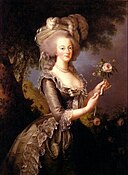
Portrét Marie-Antoinette, 1783
Pavillon de Trivaux, 1783
Death of the Dauphin in Meudon, 4 June 1789
Retour de la promenade de Mr le Dauphin (Ludvík XVII ) at the vieux château in Meudon, Jean-Baptiste Isabey, 1791. Musée du Louvre[20]
19th century: between pomp and decline
Po 10. srpna 1792, the fate of the castle became uncertain. The Národní shromáždění quickly took care to remove most of the over-the-door paintings, carefully disassembled and transferred to provincial museums, which saved them from destruction.
"Castle of the Republic" (1793-1795)
On November 4, 1793, Pierre Choderlos de Laclos, appointed chief commissioner of experiments at Meudon, took possession on behalf of the Minister of Marine of this place, where he had suggested setting up an artillery and ammunition tests[21]
But Choderlos de Laclos stayed only one day in Meudon, since he was arrested the next day. The site was transformed by the Convention into a national facility for various tests. It would serve as a factory for aerostaty and became the "castle of the Republic", which serves as a place of experimentation to arm the new regime. As such, the castle will be the object of an illumination paid by the public funds.
Nicolas-Jacques Conté was, together with several other scientists, in charge of these military and scientific experiments at Meudon, where he was given direction of the aerostation school established there. Conté had under his orders a confused gathering of young men in all professions, without any dye of chemistry, drawing, or mathematics, who were called upon to create an entirely new technique. Conté had to approach the elements of the different sciences, for this new teaching had to embrace everything: chemistry, physics, mechanics. Conté, by giving both theoretical and practical lessons, Conté had the models he gave, the instruments he imagined, executed by the hands of his pupils, spending his nights preparing drawings for his lessons, Experiences, sometimes dangerous.
- Fabrication of military aérostats at the château in Meudon. Watercolors on paper by Nicolas-Jacques Conté

Découpage des toiles pour composer des fuseaux (1/5) 
Assemblage des fuseaux (2/5) 
Préparation du vernis (3/5) 
Étalage du vernis et vérification des joints (4/5) 
Aérostat au campement sous sa tente de protection (5/5)
Château-Vieux fire and demolition

In 1795, a fire, linked to the technical research of the occupants, ravaged the chestnut tree wing and damaged the west wing of the Castle-Vieux. The castle remained in this condition nearly a decade. Many English visitors came to Meudon from 1802, and left several descriptions or drawings (for example the drawing of James Forbes). English colonel Henry Thornton Thornton, of Thornville-Royal, Yorkshire, describes the site in a letter written in English, dated August 31, 1802:
- The day before, M. Belanger had proposed to us an excursion to Meudon, a pretty park whose interior covered the walls of twenty miles, and which had been Designated as a more than desirable potential investment. A chair had been fixed on a most comfortable carriage, in view of this expedition. The castle of Meudon, originally residence of Madame de Pompadour [sic], consists of an immense block, unfortunately dilapidated. It nevertheless retains some traces of its past splendor. We were politely received by the concierge (or maybe he was the caretaker), whose manor was always likely to be converted into a pleasant one, in a beautiful park with a forest landscape covered with water jets and ponds. rezidence. This person led us to the castle, drawing our attention especially to the apartments of which the last occupant was none other than the unfortunate dauphin. I did not have time for further exploration of the park, but my guide informed me that it included farms, plains, etc., all within 500 acres, to which 10,000 acres of forest. He also told us that the walls were once partly collapsed, on the orders of the late king, in order to give the game the possibility of escape, but that these had since been repaired. He also pointed out that the estate comprised 29 water bodies of various sizes, leading me immediately to one of them, with a capacity of about 9 acres. The latter was walled and partly surrounded by a wooded landscape, but its shape offered, from a distance, a pleasant rendering. It was also necessary to take into account the presence of some fish, hares and rabbits, as well as a reasonable number of partridges on the estate. On the other hand, all the pheasants had been slaughtered. The whole of the castle, as I said before, is now in ruins, and to entirely shave it would entail considerable expense, the cement of these old buildings being particularly solid. But from the point of view of its extent and its proximity to the capital, Meudon would undoubtedly constitute a precious acquisition (...)
Malíř Hubert Robert, who was in charge of the landscaping of the gardens of Meudon under Louis XVI, comes to draw the demolition site in 1804. The Château-Vieux is destroyed from [1803]. In 1805, there is still a small part of the Château-Vieux (southwestern pavilion) as well as the chapel, as indicated by François Collet Duclos in his report of 3 Ventose 13 (February 22, 1805). The whole was the subject of excavation works until about 1808, after recovering some ornaments, including the stone columns nowadays located in the small rotunda of the Palais du Luxembourg (Senate), that the architect Jean Chalgrin was able to reuse.
Le Château-Vieux de Meudon en ruines, en 1802. James Forbes, Musée de l'Ile-de-France, Sceaux
La démolition du Château-Vieux de Meudontím, že Hubert Robert, 1804

Trois ouvriers déplacent une colonne du château de Meudon. Hubert Robert, circa 1804. Musées de Weimar, Schossmuseum, KK 9110
Démolition du Château-Vieux de Meudon, Hubert Robert, 1806. Muzeum Getty, Los Angeles (Spojené státy )
Schéma du Château-Vieux de Meudon en cours de démolition, 22 February 1805. En rose foncé, ce qu'il reste à démolir. ADY, 2Q 34
Columns from the château, taken to the rotonda of the Senate par Chalgrin
Napoleon : Meudon, Imperial Palace of the King of Rome (1807-1815)


After deciding in 1803 to demolish the Château-Vieux, which had been burnt down in 1795, and when he was only Bonaparte, Emperor Napoleon decided in 1807 to make the Château-Neuf an imperial palace. He restored the gardens and refurbished the Château-Neuf, notably by the architect Jean-Baptiste Lepère. A wing called the "Economat" was erected on the site of a part of the ruins of the chestnut tree wing. The Emperor, who wanted to make Meudon a "school of kings" in Europe, installed the Král Říma in 1811, under the responsibility of his governess, Louise Charlotte Françoise de Montesquiou. To this end, numerous orders have been made to furnish the palace of the Empire's heir (new Empire style decoration), furnishings, silks, etc.).
On April 22, 1811, Napoleon I. visited Meudon. On June 30, 1811, Meudon was placed at the disposal of Letizia Bonaparte. In April 1812, the King of Rome came to stay at Meudon.During the summer, Queen of Westphalia, manželka Jerome Bonaparte, also stayed at Meudon, with Madame Mother. The Empress was said to have resided at the palace during the Russian campaign, although she was staying at Saint-Cloud. From March 24 to November 14, 1813, the Queen of Westphalia made another visit to Meudon.
But, at the fall of the První říše, the castle lost its status of Imperial Palace.
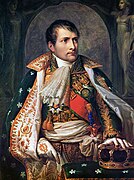
Napoleon I, as King of Italy, 1805
Projet d'aménagement of the terrace under Napoleon I. tím, že Jean-Baptiste Lepère, c 1808
Château de Meudon c. 1812, První říše

Distribution du troisième niveau du Château-Neuf sous Napoléon Ier, 1812
Fauteuils commandés par Napoléon I. for Meudon, musée de Fontainebleau
Pendule de l'Étude ou de la Méditation, vers 1810, Mobilier National.
Feu en deux parties, c. 1810-1811, gilded bronze, Jean-Jacques Feuchère, Mobilier National
Guéridon, bois de frêne bronze doré et marbre blanc, Mobilier National
Console fournie par Maigret, bois de frêne et marbre blanc, Mobilier National
Écran à glace, bois de frêne, gilded bronze, mirror, Mobilier National
Lustre placé dans la Galerie du Château-Neuf, c. 1811, gilded bronze, Feuchère, Mobilier National
Feu de la galerie du Château Neuf de meudon, Mobilier National
Meudon under the Restoration and the Orleans


Louis Ludvík XVIII, Karel X. a Louis-Philippe used Meudon as a hunting ground near Versailles, eminent.
Charles Ferdinand, son of Charles X, went there to hunt between 1815 and 1820.
After his abdication of the Imperial throne of Brazil on April 7, 1831 Peter I of Brazil) returned to Europe and settled in France with the title of Duke of Braganza. In the autumn of 1831 he spent some time at the Château-Neuf, an estate the king Louis-Philippe freely put at his disposal. During his stay in France, he became a friend of the famous General La Fayette.
A stud[je zapotřebí objasnění ] was then installed below the old gardens at the bottom of Meudon. The Prince of Orleans, under the July Monarchy, stayed there in 1834 and wrote his memoirs there. But he died accidentally in Neuilly-sur-Seine v roce 1842.
Louis-Philippe also made available the castle of Meudon to Marshal Soult, who stayed there several times in summer.
On May 8, 1842, a railway catastrophe took place in Meudon, in which Jules Dumont d'Urville zahynuli. It was the first in France and one of the first in the world. Louis-Philippe I. offered the Château-Neuf to treat survivors.
After the revolution of 1848, plans were made to make Meudon the new headquarters of the Ecole Polytechnique (Ecole Polytechnique). But these grandiose projects, one of which was established by the architect Hector-Martin Lefuel, in the end did not see the light of day.
Meudon, pris des murs du haras, par Bergeron. Vers 1825. BNF.
Détail d'une porcelaine de Sèvres représentant le Château-Neuf de Meudon sous Louis-Philippe. Musée de Fontainebleau, Galerie des Assiettes.
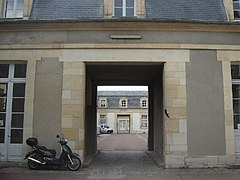
Les écuries du château de Meudon, conservées.
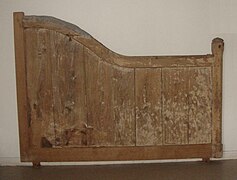
Stalle du XIXe siècle provenant des écuries du château.
Second Empire: the hideout of Prince Napoleon

Although Meudon was assigned to Prince Jerome's strýc z Napoleon III, he did not visit the property. On the contrary, from 1860 to 1870, his son, Napoleon Bonaparte, cousin of the Emperor Napoleon III, often occupied Meudon. In Paris he owned the famous Pompeian house sheltering his connection with the actress Rachel Felix, but it was to Meudon that he cames to "sulk" the protocol at the imperial court, of which he was not fond. He brought his wife Marie-Clotilde of Savoy and her three children, Louis Bonaparte (1864-1932), Louis Victor and Marie Laetitia. He collected many species of plants and exotic animals, brought back from his travels abroad. Several large receptions were organized at the castle, such as the one in honor of Louis I, king of Portugal, in 1867.
Château-Neuf de Meudon c. 1860
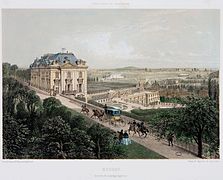
Meudon from the upper terrace. "Paris dans sa splendeur". Chapuis del.
Recepce pro Louis já Portugalska dána Princ Napoléon, salon-serre of the Château-Neuf (former upper vesti
Meudon kennels and Princ Napoleon 's dog
1871 Château-Neuf fire and takeover by the Observatoire de Paris



Because the site is strategic, dominating Paris, a battery of Prussian artillery was installed there in 1870. The new castle caught fire on 31 January 1871 and burned for almost three days. Hypotheses on the cause included either a deliberate fire set by the Prussians as they left, or a bombardment by La Douai , a naval cannon, placed in bastion 74 of the Thiers precinct. The ruins were preserved for several years, until the site was entrusted to astronomer Jules Janssen in 1875. Janssen did not hesitate to raze nearly half the Château-Neuf, and together with architect Constant Moyaux, between 1880 and 1885 built there an astronomical observatory, later attached to the Pařížská observatoř v roce 1927.
Since then most of the estate (high preserved gardens) has been closed to the general public, and remains so to this day.
- Drawings and photographs, Château-Neuf ruins

The Château-Neuf after the fire of 31 January 1871

Photograph of the Château-Neuf after the fire, 1871. Private collection
View of Meudon after the war of 1871. Hubert Clerget, Musée Carnavalet
Photograph of the lower vestibule of the Château-Neuf after the 1871 fire
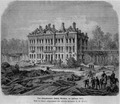
The ruins of Château-Neuf and surroundings, February 1871

The 20th century: a gradual renovation


Over the years, vegetation has encircled the Orangery, making it inaccessible. The destruction of the old village of Meudon after the war, and the reconstruction of the city center, has removed the once picturesque setting of multiple roofs at the foot of the old castle. The notion of heritage did not gain traction in French society until the 1970s and 1980. The entire estate is now registered as a historic monument, though this was done very late for such a historic site, while similar large estates in Ile-de-France had been declared historic well before.
The domain today
Although the Château-Vieux was destroyed, it still retains much of the splendor of the domain. In fact, 40% of the surface area of the original buildings, (the remains of the Château-Neuf, orangerie, communes, etc), still exists. One can still admire the avenue of the castle traced by Louvois, the guardhouses and common of the Grand Dauphin, the kennel of Louvois, the great prospect of Servien, the nymph and the orangery of Louis Le Vau, and one can imagine the terraced gardens below the observatory, as well as the pond of Chalais and the green carpet. And above all, the large terrace, the most impressive achievement, is perfectly preserved. The orangery of Meudon was completely restored in 2012.
Thanks to its exceptional location (Paris-Versailles, the most touristic area in France) and its panoramic view of Paris (one of the most spectacular in Ile-de-France), the site is a tourist and economic hub.
The domain today

Aerial view of the Orangery and the remains of the Château-Neuf converted to an observatory

Aerial view of the terrace with the avenue of the château, towards the north

Aerial view of the old stables of Meudon

Aerial view of the terrace at Meudon, with the Bel Air pond
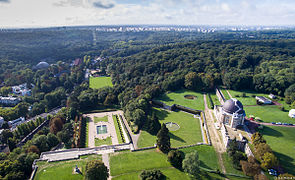
Aerial view of the Grande Perspective towards the south

Aerial view of Paris from Meudon
View of Paris from Meudon, 2013

The great dome of the observatory, built on the remains of the Château-Neuf
Les restes du Château-Neuf converted to an observatory. 2014
L'Orangerie de Meudon, 17th century, restored in 2012
View of the commons of the château, conserved today. 2009
The contreforts of the terrace of the old parterre of the château de Meudon, 2013

The high terrace today
The Grande Perspective at Meudon, condition in 2010

Bel Air pond today
Porte dauphine, 1703

Pond of Chalais, before the Grande Perspective, today.
Panoramic view of the Grande Terrasse at Meudon, 2013
Legal status: a split and partly inaccessible space

Today, the domain of Meudon is divided in two parts.
The lower part: The large terrace and the oranžerie jsou spravovány město and are freely accessible to the public.
The upper part: The Observatory (Chateau-Neuf), the high gardens, as well as the communes situated at the entrance, come under the Ministry of National Education and are assigned to the Observatory of Paris. They are closed to the public.
The State still owns the entire estate, both the part assigned to the Observatory and that which is managed by the city government.
However, as regards the part of the domain accessible to the public, the State has signed a management agreement for the national domain of Meudon with the town of Meudon, which now manages it. Financially, the State still plays its role as owner and manages the pruning and maintenance work. It leaves it to the City to manage the site located within its territory.
The rehabilitation project of the Great Perspective

The project to reconstitute the Great Perspective of Meudon was launched as early as the 1980s, but has made little progress to date. Nevertheless, it continues, in consultation with the parties concerned. Indeed, three quarters of this major landscape axis of Ile-de-France, due to André Le Nôtre, are preserved. Only the part between the parterre of the orangery and the pond of Chalais remains blocked.

Archeologický potenciál

No excavation has ever been undertaken on the site of the Chateau-Vieux. However, the demolition records are formal: all the cellars and ditches remain under the current lawn. An archaeological campaign could make it possible to highlight this hidden heritage.
The only unknown parameter is the exact nature of the impact on the subsoil at the Château-Vieux right-of-way during the Prussian occupation in the Franco-Prussian War of 1870. Indeed, The Prussians occupied the whole terrace of Meudon, to bombard the capital and follow the operations.

Detail of the domain
Vieux-Chateau


The Château-Vieux was the central building of the estate, and the first historical castle at Meudon. It aligned with the Great Perspective.

Přízemí

Velký vestibul a velké schodiště
Tyto místnosti byly vytvořeny, když Louis Le Vau přestavěl centrální pavilon hradu na Abel Servien mezi 1655 a 1658.
Malá předsíň, 1658 až 1803
Průřez Grand Escalier (velké schodiště) 1658 až 1803
Průřez Velkého vestibulu (velký vestibul), 1658 až 1803
„Grand Apartment“ Monseigneur
Toto bylo hlavní obydlí v Meudonu v Louis, Grand Dauphin (1661-1711), syn Ludvíka XIV., V přízemí východního křídla Château-Vieux. Zachovalo se neporušené po celé 18. století.
Ve své konečné konfiguraci, počínaje rokem 1701, byla složena postupně z:
- Strážní místnost;
- Jídelna oživená čtyřmi plátny z Bakchus;
- Kulečníková místnost zdobená čtyřmi oválnými plátny na mytologické předměty;
- Předpokoj;
- Ložnice dauphina, kde 14. dubna 1711 zemřel na neštovice;
- Rohová skříňka;
- Z malé dřevěné skříně ve stylu Capucine;
- Stejně jako malé mezipatro, zalesněný Capucine;
Strážní místnost

Blondel upřesňuje ve svém Françoise Architecture : „V Domě stráží, v Královském domě, se nazývá velká místnost, kde se konají stráže prince, a proti panelům, z nichž jsou připevněny karabiny, aby složili zbraně; Také se umisťují do těchto druhů umístí bubny, což jsou druhy stolů, na kterých se počítá, a na které dno během dne dostává postele, ve kterých si Gardes du Corps odpočívá v noci. Tyto místnosti musí být prostorné, velmi vysoké, velké komíny a zdobené jednoduchostí. Podívejte se na Versailles, Meudon, Chateau des Thuileries ... “.
Jídelna Dauphin (od 1700)

Inventář z roku 1775 naznačuje, že od práce ve zvětšení roku 1700 je místnost „zalesněnou výškou pozlacených rámů, římsou stejných, komínem ze zeleného mramoru ...“. V roce 1700 Monseigneur pověřil čtyři různé malíře malováním „bacchických“ předmětů. Stejní umělci pak zdobili velký salon Chateau de Marly.
- Podle Charles de La Fosse (1636-1716): Bacchův triumf, nesený na slonu, s jeho tyrsus v pravé ruce několik Baccantů kolem sebe neslo nástroje. V popředí jsou dvě děti, jedno namontované na tygrovi, nalevo na zadní straně Silenus. (Muzeum Louvre, INV č. 4537).
- Podle Jean Jouvenet (1644-1717): Zrození Bakcha Merkur, který letí poté, co jej dal do rukou Nymf. To souvisí s legendou o Semele, jeho matka, kterou miloval Jupiter, a jejíž neštěstí získá Juno z blesku.
- Podle Bon Boullogne (1649-1717): „Venuše, Bakchus a Ceres, vědět "Úryvek z Horace, který říká, že bez dobrého milého Venuše se ochladí; Na levé straně obrázku je Baccus, který lisuje hroznový hrozen do šálku, který drží Flora; Vedle ní Ceres, který se na ni dívá ; Ve spodní části, pod mřížemi, je oblečený bufet; Ve středu obrázku dole jsou dvě malá děti, které, zdá se, žádají o pití, leží na tygrovi. “Tento obraz je zachován v Muzeum Louvre, kde se mu říká „Bacchus a Ariane“. To je také jmenováno ve starověkých inventářích Bacchus a Ariane, Bacchus a Erigone nebo Bacchus, Flora a Ceres. Na konci roku II., Který byl poslán do Ústředního muzea, ztratil své přičítání, ale zůstal v Louvru, kde byl nalezen mezi anonymními členy francouzské školy (inv. 8608). Má být obnoven.
- Podle Antoine Coypel (1661-1722): Silenus potřený ostružinami vílou Eglé. Téma je převzato z epizody Virgilových „Eclogů“, číslo 6 s názvem „Silenus“, ve kterých Virgil píše: „A jak starý muž otevírá oči, červená si čelo a chrámy džusu Bloody of the Blackberry. " Silenus, který po svém obvyklém pití spal v jeskyni, je překvapen dvěma satyry a vílou Egle, pro kterou slíbil zpívat. Oba satyři se zmocnili Silena, kterého svázali břečťanovými stonky, zatímco krásná Egle zrudla její tvář ostružinami, které rozdrtila, aby z její hrozby vytrhla splnění jejího slibu. Měření: 4 stopy 9 palců x 4 stopy 1 palce. Obraz byl podstatně zmenšen v devatenáctém století. Je zachována v Muzeu výtvarného umění v Remeši, INV. D.872. 2. 5.
- Obrazy v jídelně Monseigneur v Meudonu v 18. století
Silène potřená moruškami od nymphe Eglé, Antoine Coypel. 1701. Musée des Beaux-Arts de Reims.
Bacchův triumf, Charles de la Fosse, 1701. Musée du Louvre.
Narození Bakcha, Jean Jouvenet, 1701. Soukromá sbírka
Vénus, Bacchus a Ceres, Bon Boullogne, 1701. Musée du Louvre.
Kulečníková místnost
Počínaje rokem 1700 bylo staré schodiště Louvoise a Julese Hardouina-Mansarta odsouzeno k vytvoření řady místností, včetně „Salon du Billard“. Soupis z roku 1775 naznačuje, že místnost je „zalesněná do výšky, se zlacenými rámy, zlacenými římsami, komínem z gryotského mramoru“. Monseigneur objednal pro tento pokoj sérii malby přes dveře, stejné velikosti a oválného tvaru. Je to o:
- Z Charles de La Fosse: Herkules mezi neřestí a ctností; „V horní části obrázku Moudrost, představovaná Minervou, jejíž dítě nosí štít, ukazuje Herkulesovi chrám paměti nalevo. Výška 4 stopy 10 palců; L. 3 stopy 5 palců; ovál. Horní část dveří. Kulečníková místnost Za provedení této práce byl Charles de La Fosse dvakrát vyplacen 600 livrů v roce 1700 a 200 livrů v roce 1701 „za dokonalou platbu 800 livrů za obraz, který vytvořil v Meudonu, představující Herkula“ (CBR t IV col 675). Obraz namalovaný v roce 1700 měl formát 3 stopy 10 palců2 krát 3 stopy 5 palců. Villot správně identifikoval obraz Meudona pomocí plátna, nyní obdélníkového, v muzeu Nevers v roce 1872 (Pozvánka Villot, n. ° 4538, 1 m 20 x 1 m 09).
Z Jean Jouvenet: Latone a rolníci z Lycie, kde jeden objeví „Latone se svými dvěma syny žádajícími vodu od rolnických Lycia, kteří se odmítli projevit v prosbě, zvedli ruce vzhůru a vzývali Jupitera, který je proměnil v žáby; na dně krajiny se objevuje stádo krav, které přecházejí přes okraj bažiny. “Kopie tohoto díla je uchována v Muzeu umění a historie Meudonu, dalším, nepochybně originálním, na zámku Fontainebleau (IV pl. 675). Je inspirován přímo centrální bílou mramorovou plastikou fontány Latona v zahradách Versailleského paláce.
- Z Louis de Boullogne mladý muž: Cephale a Procris který dává šipku svému manželovi; Má nataženou levou paži a ruku položenou na psech, které, zdá se, hladí; V horní části obrázku se objeví amor, který nese pochodeň panenské blány. ". Po uložení v Compiegne (8676) byl obraz v roce 1962 odeslán do Musée de Saint-Etienne pod názvem: Venuše a Adonis a přidělen omylem Bon Boullogne. Jeho starobylý oválný tvar je jasně viditelný. Obraz byl vyroben a pózoval v roce 1700, as David a Abigail pověřen stejným malířem. Přípravné kreslení se koná v Cabinet des Arts Graphiques v Louvru (inv. 24961).
- Antoine Coypel], tehdy nejmladší malíř ze čtyř: „Herkules přivádí zpět Alcesta z podsvětí; Výška 3 stopy 10 palců; Šířka 3 stopy. Jedná se o otázku „Herkules se vrací k Admetusovi, jeho manželce Alceste, kterou přináší zpět z podsvětí“, obrázek, který Meudonovi přinesl sám Antoine Coypel. (CBR t IV col 675). Obraz byl umístěn před květnem 1700, podle vzpomínek citovaných F. Engerandem (Inventory of the Royal Tablets, Paris, 1899, s. Charles-Antoine Coypel, syn malíře, ukázal novost těchto literárních předmětů. obraz Meudona, Antoine Coypel přeložil Mmě Dacier páté dějství tragédie Euripides. Obraz je zachován v Cholet Museum of Art and History, Cholet Museum of Art and History. Dílo mělo dříve název „Hercules Delivering Theseus“! V květnu 1700 přišel k Meudonovi sám Antoine Coypel, aby své dílo nainstaloval jen stěží.
- Čtyři oválná plátna v kulečníkové místnosti Monseigneur v Meudonu po celé 18. století
Latone et les paysans de Lycie, Jean Jouvenet, Musée d'art et d'histoire v Meudonu
Hercule entre la Volupté et la Vertu (Hercules Between Voluptuousness and Virtue), Charles de La Fosse, Musée de Nevers
Hercules přináší Alceste z pekel, Antoine Coypel, Musée d'art et d'histoire de Cholet
Céphale et Procris, Louis de Boullogne le Jeune, Musée des Beaux-Arts de Saint-Étienne.
Předpokoj (bývalá jídelna Dauphinů od roku 1695 do roku 1699)

Bývalá „jídelna Monseigneur“, která měla tuto funkci v roce 1695, se po zvětšení bytu stala skutečnou předsíní. Inventář z roku 1775 uvádí: „Místnost osvětlená dvěma okny, obložením zlatými rámy, zlacenou římsou, stropem ve zlacené arabesce a malovaná Audran. Jacques-François Blondel připomíná jeho obdiv k těmto stropům arabesek od Meudona, i když odsuzuje styl stropu, který zdobí obydlí prince:
«D'ailleurs l'on peut réduire ces ouvrages à des nuages avec des Génies, & à quelques belle grisaille qui en forme les extrémités; výzdoba préférable à ces riches, mais peu vraisemblables peintures grotesky, dont on voit d'ingénieux desseins d'Audran, & qui sont exécutées avec un succès étonnant dans quelques appartements de Meudon, aussi bien que dans les plafonds la Ménagerie: seul bâtiment où ce žánr de peinture soit pohodlný ».
Inventář z roku 1775 dodává, že se zde nachází také „zelený mramorový komín Campan, vrchol krbové římsy zdobený mramorem jakékoli výšky se zlato-bronzovou výzdobou z mletého zlata, zrcadlo na dvě části, prvních 52 palců širokých a 96 palců vysoký, druhý 52 palců stejný jako 26 palců vysoký Dva stoly nad dveřmi každé 3 stopy 6 palců široké a 2 stopy 9 palců vysoké, představující ovoce a květiny, namalované Batiste Fontenay “.
V této předsíni dauphin umístil sbírku obrazů nabízených Ludvíkovi XIV. V roce 1693 André Le Nôtre a kterou dal král k dispozici svému synovi. Tato díla jsou nyní zachována v muzeum Louvre.
Ložnice Grand Dauphin

Inventář z roku 1775 naznačuje, že komora Dauphina vlastní: „Stěnové panely ze zlacených rámů, zlacené římsy, zlaceného stropu a malované v arabeskách Claude Audran III, mramorový krb serancolin, horní část z fialově hnědého mramoru, celá velmi zdobená bronzem pozlaceným mletým zlatem. (...) Dva obrazy nad dveřmi o šířce 3 stopy, 5 palců a 4 stopy, 1 palce představující plody namalované Batiste. “Právě v této místnosti zemřel Monseigneur 14. dubna 1711. Tento komín vzrušoval zvědavost výzkumníků : slavný malý obraz zachovaný ve Versailles, představující „vladaře v jeho kabinetu práce s vévodou z Chartres“ od Fiske Kimballové jako představitele Dauphina v Meudonu. Samozřejmě tam najdete typ nábytku a dekorací, které by mohly zdobit hrad. Ale Jerome de La Gorce klade správnou otázku:
„Opravdu tento interiér existoval? Není divu, že komín, obložení vlevo od dveří a stůl, to znamená většina prvků dekorace, jsou v rytém díle Beraina totožné? ne malíř, jehož kariéra je stále nejasná, využil desek vydaných navrhovatelem k rekonstrukci rámce hodného osobností, které zastupoval? Soupis vybavení koruny zmiňuje v roce 1695: „[č. ] 1615 - Čalounění [sic] červeného a žlutého saténového sametu, vyšívané a lemované stříbrem, uvedené před číslem 783, které bylo vylepšeno a vybaveno tak, aby sloužilo Monseigneur le Dauphin v Meudonu, nyní sestávající z plné postele, čtyř křesel, osm skládacích sedadel, dvě tabule, dvě dveře, šest listů obrazovek, obchodní židle a dva tapiserie “.
Kromě toho Monseigneur vzal do svého pokoje malý ebenový stůl pokrytý mědí a želvovinou, který koupil v Godronu, který měl náhorní plošinu podepřenou osmi bronzovými karyatidami, přičemž uprostřed intarzie byl jeden amor na escarpolette. Kromě tohoto stolu byl v místnosti stůl a dva podstavce, jejichž tablety byly zdobeny čínskými groteskami s postavami a ptáky.

Rohová skříňka


Inventář z roku 1775 naznačuje, že místnost je vyzdobena „Nástěnnými panely s velkými zlatými rámy, zlatou římsou, zlaceným stropem s arabeskami namalovanými Audranem. Komín z mramoru fialového brekcie, vrchol zdobený mramorem celé výšky s bronzy velmi bohatými na děti a ozdoby pozlacené z mletého zlata (...). Stejně jako ve dvou předchozích místnostech, Audran zdobil arabesky strop: „Když král přišel do Meudonu 22. dubna 1699, odešel 24.; O dva dny později, 25. dubna, dostal Mansart rozkaz od Monsignora, aby nechal vymazat obrazy stropu své rohové skříňky, vytiskl ji třemi vrstvami bílé a namaloval takovou groteskní podobu v místnosti Dauphin. „Strop, který byl poté vymazán, může být pouze ten, který realizoval Charles de La Fosse pro Louvois, jehož předmětem je Pandore, a jehož modello bylo identifikováno Clémentine Gustin-Gomez. V roce 1702 bylo nalezeno: „Ve Velkém kabinetu monseigneurů: pět porcelánů, 630 Louis; dva bronzy 180 Louis. Stéphane Castelluccio označil tyto dva bronzy za Laocoon a Lutteurs, za což Monseigneur jistě velil jejich bohatým „intarzním chodidlům“. Nakonec soupis královského nábytku (Tome II, s. 434, 1697) označuje pod číslem: „1768 - Čtyři kobercové rohože pruhované dvěma prameny vlny s několika barvami pro okna skříňky Monseigneur v Meudonu. “
Saint-Simon, popisující smrt Velkého Dauphina, nám říká, že právě v této místnosti se večer 14. dubna 1711 odehrává slavná scéna příchodů a odchodů mezi rohovým „Kabinetem“ Králem, a sousední místnost, kde Monseigneur umírá:
„Když se chystal vstoupit do místnosti, princezna z Conti, která měla čas běžet k Monseigneurovi v tom krátkém intervalu u stolu, se představila, aby mu zabránila ve vstupu do místnosti. Dokonce ho odstrčila a řekl mu, že už nesmí myslet na nic jiného než na sebe. Potom se král, téměř ve slabosti tak náhlého a úplného zvratu, pustil na gauč, který byl u vchodu do dveří skříně, kterou vstoupil , který se dostal do místnosti. Zeptal se na všechno, co z toho vyšlo, na novinky a sotva se někdo odvážil odpovědět. Madame de Maintenon pospíchala ke králi, posadila se na stejnou pohovku a pokusila se plakat. král, jehož vozy již byly na nádvoří připraveny, ale neexistoval způsob, jak ho přimět, aby si uvědomil, že Monseigneur vypršel. Tato bezvědomá agónie trvala téměř hodinu poté, co byl král ve skříni. Vévodkyně a princezna de Conti se rozdělily mezi péčí o umírajícího a příbuzného g, ke kterému se často vraceli, zatímco zmatená fakulta, rozrušení komorníci, bzučivá kurtizána se navzájem tlačili a kráčeli beze změny místa “.

Schéma stropu rohové skříňky, vymazané dauphinem v roce 1699

Arabesky na zlatém pozadí od Clauda Audrana III, kolem roku 1700. Archives des Arts décoratifs de Paris, inv. 5482 A. Pro Ménagerie de Versailles nebo pro byt Dauphin v Meudonu

Další dekory od Audrana, inv. 5482 B
Byt zvaný vévoda a vévodkyně z Burgundska
Bylo umístěno mezi Velkou vestibulí a bytem Monseigneur.
Tyto pokoje byly hlavním bytem Abel Servien, který tam zemřel ve svém pokoji v přízemí v roce 1659.
Když Monseigneur se usadil v Meudonu v roce 1695 a dal toto obydlí vedle svého bydliště Filipu Orleanskému (1640-1701), který jej obýval až do své smrti v roce 1701. Obytné místo pak až do své smrti obýval vévoda a vévodkyně Burgundska v roce 1712.
Pokoje v přízemí

V prvním patře byly velké přijímací místnosti, zejména „Salon des Moures“ a galerie.
Salon des Maures


Abel Servien vytvořil tento oválný pokoj, středobod hradu, který vyhlíží na parter. Tento salon byl postaven ve stejné době jako salón v Château de Vaux-le-Vicomte byl postaven pro Nicolas Fouquet, a je podobný, i když o něco menší. The kopule neobdržela žádnou malovanou výzdobu. Gabriel Blanchard dvanáct grisailles pod římsou, kterou popisuje inventář z roku 1733: „Ve stejném salonu je dvanáct obrazů namalovaných v grisaille představujících dvanáct měsíců roku hrami„ dětí, jsou z damoiseletu [faux, od Gabriela Blancharda] a nemohou zvedněte místo, kde jsou všechny zázraky, dvě stopy vysoké, 6 stop 5 palců široké.
Louvois umístil do tohoto salonu dvanáct termínů z maurského a maurského mramoru, z nichž osm je nyní v paláci Compiegne, přenesených tam na samém konci 18. století. Ministr také vyzdobil podkroví sedmi obrazy květin od Jean-Baptiste Monnoyer. Soupis obrazů Meudona z roku 1733 je popisuje:
1. „zlatá váza naplněná všemi druhy květin, položená na modrém koberci vyšívaném zlatem - spodní část obrázku je obloha.“ 2. „zlatá váza nebo spíše agatický způsob, jehož úchyty jsou ze zlata, naplněné všemi druhy květin, koberec, za nímž je vyšíván zlatem, se dvěma papoušky, jedním modrým a druhým žlutým.“ 3. „Zlatá zdobená váza goderon naplněná všemi druhy květin - koberec za vyšívaným zlatem s červeným a zeleným papouškem“ .4. „váza ve tvaru stříbrné mísy naplněné nejrůznějšími květinami umístěná na červeném koberci vyšívaném zlatem s pávem na misce.“ 5. „zlatá váza zdobená všemi druhy květů, z nichž jedním z listů padá mák na podstavec, na kterém je váza položena.“ 6. „Zlatá váza položená na chodítku naplněném všemi druhy květin s pávem za vázou.“ 7. „zlatá a stříbrná váza na modrém a zlatém koberci, jehož podšívka je karmínová a opice drží rybu.“
- Les termes en marbre de maures et de mauresques, Salon des Maures de Meudon. Aujourd'hui au palais de Compiègne.

Terme féminin, C38.120 MR 2494.
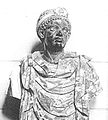
Terme maskulin, C38.98 MR 2492.

Terme féminin, C38.129 MR 2495.

Terme maskulin, C38.122 MR 2497.
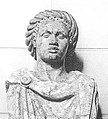
Terme maskulin, C38.97 MR 2496.

Terme maskulin, C38.121 MR 2493.
Předpokoj nazýval hry

Po Salon des Maures sloužila řada přijímacích místností jako místnosti pro hry a jakoby pro takzvané „bytové“ večery, jako ve Versailles. První místnost po oválném salonu byla čtvercová a měla dvě okna na straně jámy. Dauphin Monseigneur visel na zdi tapiserie Dějin krále, aby potěšil svého otce.
Herní místnost
Druhá místnost byla podobná té první a byla také obohacena závěsy, severní zátoky byly za tímto účelem ucpané.

Salon du Petit Pont

Tato rohová místnost byla jedním ze dvou salonů rámujících galerii. Měla přístup k „Petit Pont“ (malému mostu), který vedl přímo do vysokých zahrad. Byla tam umístěna Alexandrova porfyrová busta.
Galerie starého hradu


Galerie Meudon měla rozlohu 300 m² a hlavní místnost měřila 40 metrů. Byly zde také dva salony, Salon du Petit Pont a Salon des Albane na severu.

- Van der Meulen plátna pro galerii v Meudonu

La prize d'Ypres

La prize de Fribourg

La prize de Condé
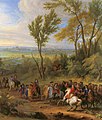
La prize de Lau
- Čtyři sochy umístěné ve výklencích galerie pod Monseigneurem

La Fidélité (Fidelity) podle výkresu Pierre Mignard, Jardins de Versailles

La Fourberie, podle kresby od Pierre Mignard, Jardins de Versailles

Aurora nebo svítánítím, že Gaspard Marsy, podle kresby od Charles Le Brun, Jardins de Versailles.

Flore tím, že Philippe Buyster (1595-1688)
- Sochy a nábytek umístěné v galerii v Meudonu

The Alexander Mazarin. Musée du Louvre
Busta malíře Raphaëla od Alessandra Rondoniho
Busta Annibala Carracheho, Alessandro Rondoni

Jupiter a Junon, bronz u Algarde. Wallace Collection, Londýn
Osmiboké podstavce umístěné v galerii. Opatství Chaalis

Salon Albane

Tato komora končí galerií a je přívěskem Salon du Petit Pont v symetrii. Salon je pojmenován pro malíře Francesco Albani, protože v rozích bylo umístěno několik oválných pláten, kopie byly znovu interpretovány z mistrovy práce. Architektura místnosti se svými výklenky zdobenými zrcadly a klenutým stropem byla inspirována přímo kabinetem medailí Ludvíka XIV ve Versailles.
Dauphin tam umístí velké bronzy L'Algarde, Jupiter a Juno.
V bytě bylo řečeno o Ludvíkovi XIV

Na konci 19. století se byt Ludvíka XIV skládal z předpokoje, královské komory, malého průchodu do zadní části, ze „kabinetu zrcadel krále“, který měl balkon umožňující obdivovat výhled na Paříž.
Předsíň Rady

Tento pokoj bez dřeva měl tři okna na straně podlahy a dvě francouzská okna na straně dvora umožňující přístup na balkon. Krbová římsa byla z kampanského zeleného mramoru.
Ložnice Ludvíka XIV. V Meudonu

Nad krbem v královské komnatě visel originál „Charity“ od Andrea del Sarto, pak kopie tohoto obrazu. Tuto práci lze interpretovat jako alegorie přenosu královské moci.
Skříň královských zrcadel
- Le Cabinet des Glaces du Roi, asi 1697 až 1793. Archives nationales, O1 1768 A 1 et 2.
Elévation de la paroi Nord.
Elévation de la paroi Est.
Elévation de la paroi Sud.
Elévation de la paroi Ouest.
Restitution 3D du Cabinet des glaces de Louis XIV, Franck Devedjian & Hervé Grégoire, Janvier 2013.
Apartmán Madame de Maintenon

Byt madame de Maintenon, který sestával z předpokoje, ložnice a skříně ve středu východního křídla, měl prospěch z balkonu s výhledem na Paříž. V Maintenonově kabinetu byl nad dveřmi, zejména obraz Louise de Boullogne s Davidem a Abigail.

Předsíň M.mě de Maintenon, c. 1700

Chamber of Mme de Maintenon, 1700-1711

Kabinet M.mě de Maintenon, c. 1700
Apartmán princezny z Conti


Poté následoval byt princezny z Conti a skončil dalším „Cabinet des mirroirs“.
V místnosti princezny byly dva obrazy od Antoine Coypel, Psychika objevující Spící lásku, a Psychika opuštěná láskou
V přilehlé skříni byl od stejného malíře umístěn obraz „Venuše v kovárnách Lemnos“. Tyto tři práce byly zadány Monseigneur za byt jeho nevlastní sestra.
- Plátna v bytě princezny z Conti od Antoine Coypel, 1701

Psyché découvrant l'Amour endormi, Antoine Coypel, 1701

Psyche Abandoned, Antoine Coypel, 1701

Vénus aux forges de Lemnos, Antoine Coypel. 1701
Kaple

Kaple byla dokončena na konci roku 1702 podle plánů Jules Hardouin-Mansart. Tuto stavbu, požadovanou Monseigneurem, mířil Ludvík XIV. Tato kaple navazuje na stejný model jako Královská kaple na zámku ve Versailles a Královská kaple ve Versailles. Kaple Meudon však byla dokončena deset let před Versailles. Stejně jako druhý z nich má hlavní loď s klenutým válcem končící ve slepé ulici nad svatyní. Nad hlavním oltářem je velká malba Antoine Coypel, vysoký čtyři metry, široký osmdesát pět krát tři, který se vyznačuje „Vzkříšením“. Charles de La Fosse bude modelovat tuto kompozici, aby provedla malování pece královské kaple ve Versailles. Další obraz Coypel, Zvěstování, dokončí sadu.
Ramena vyřezaná nad tribunou jsou královskými zbraněmi na kresbě vyčnívající do kaple, ale nakonec budou realizovány podle modelu zbraní delphinales. Teoretik architektury, Jacques-François Blondel uvádí jako příklad kaple Châteaux de Sceaux a Clagny "Dokonalé modely".
Bude zničeno v letech 1805 až 1808.
Coupe de la tribuna kaple zámku de Meudon, 1701
Projet non définitif de coupe kaple Meudon. Dessin de Jules Hardouin-Mansart, 1701. AN.
Plán définitif kaple Meudon, kolem 1775-1780. AN
Jeton představující interiér kaple zámku Meudon, při pohledu z tribuny, 1703. Soukromá sbírka
Kopie Vzkříšení Antoine Coypel, kaple Vernon
L'Annonciation, Antoine Coypel. Estampe de Drevet
Kaštanové křídlo

Starý „Cour des Offices“ nebo „Basse Cour“ byl transformován pomocí Monseigneur vytvořit luxusní obřadní místnosti. Celá příloha pak převzala název „Křídlo Marronniers“. Velké přijímací místnosti rozšiřují šířku Terrasse des Marronniers. Za těmito velkými místnostmi byl také uspořádán malý luxusní byt, „Malý čerstvý byt“, o kterém Dauphin nepochybně přijal své milenky.
Malá závěsná galerie

Tato galerie odkazuje na komunikující galerii, která na ni kolmo navazuje. Velký bufet namalovaný Fontenayem završuje perspektivu malé zavěšené galerie.
Komunikující galerie
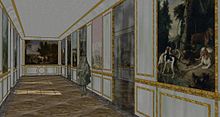
Tento pokoj je vyzdoben velkými obrazy od François Desportes, pověřený pro komoru, a který by měl úspěch malíře.

Komunikační galerie, křídlo kaštanového stromu, kolem r. 1703. Rekonstrukce od Francka Devedjiana, 2012
- François Desportes plátna zadaná pro komunikující galerii, 1703
Un cerf poursuivi par des chiens (Jelen pronásledovaný psy), François Desportes, 1703

La mort d'un chevreuil (Smrt jelena), François Desportes, 1703

La meute de Monseigneur (Hounds of Monseigneur), 1703, Musée de Gien
La mort du loup (Smrt vlka), François Desportes, 1703

Un sanglier chassé par huit chiens (Kanec pronásledovaný osmi psy), François Desportes. 1703
Velká oválná skříňka "


Také se jí říká „Salon doré“ (zlatý salon), kde visel „Bacchusův triumf“ od Bon Boullogna. Obraz zmizel, ale přípravná kresba zachovaná v Albertině ve Vídni a připisovaná jeho bratrovi Louisovi nám umožňuje pochopit, jak může vypadat kompozice tohoto díla.
Velká rohová skříňka

Dauphin měl v této místnosti několik prestižních obrazů, včetně Renaud a Armide podle Dominiquin, a Mojžíš zachránil před vodami Nicolas Poussin. Tato plátna pocházejí z královských sbírek.
Velký salon
Byla to hlavní místnost bytu gaštanů o rozloze 100 m². Dauphin tam umístil další obrázky z královských sbírek, včetně dvou od Paul Veronese.


Essai de restitution de la coupe de la paroi Est du Grand salon des Marronniers, circa 1705

Essai de restitution de la coupe de la paroi Sud du grand salon des marronniers, kolem 1705. S obrazy umístěnými Monseigneurem dauphinem.

Essai de restitution de la coupe de la paroi Ouest du Grand salon des Marronniers, circa 1705
- Plátna od Nicolas Loir z královninho bytu ve Versailles, který byl znovu použit ve Velkém salonu.
Pithopolis faisant servir des mets en nebo au roi Pithès (Pithopolis, kde král Pithès podával jídlo ze zlata), Nicolas Loir, dříve „Cléopâtre qui, dans un festin ....“, Musée de Brou.
Reine donnant audience à un vieillard (Queen Giving Audience to an Old Man), Nicolas Loir, také známý jako La reine de Saba (Královna Saba), Musée Hyacinthe-Rigaud, Perpignan
Reine s'adressant à des soldats (Dueen oslovuje vojáky) nebo „la reine de Saba appuyée sur son trône“ (královna Saba opírající se o její trůn), Nicolas Loir, Musée du Louvre, č. 8715
Jídelna

Právě v této hale biskup pozval hosty k večeři.
Skříň bufetu
Tato malá místnost měla dvě malá umyvadla, ze kterých tekly proudy vody.
„Malý čerstvý byt“
Za těmito velkými přijímacími místnostmi dostal princ „malý nový byt“, který sestával z předpokoje a další místnosti. Kromě skříně ji oživily miniatury namalované Jean Cotelle starší, představující zahrady ve Versailles. Tyto tři místnosti byly zalesněné u Capucine a zdobeny dveřmi od Jean-Baptiste Belin.


- Miniatury zahrad ve Versailles, kvaš Jean II Cotelle

Le Bassin de Neptun (Neptunova pánev), Jean II Cotelle

L'arc de triomphe, Jean II Cotelle

L'Encelade, Jean II Cotelle

L'entrée du labyrinthe (Vstup do labyrintu), Jean II Cotelle

La fontaine du dragon (Fontána draka), Jean II Cotelle

La kolonáda, Jean II Cotelle

L'intérieur du labyrinthe (Interiér labyrintu), Jean II Cotelle

Le Théâtre d'eau (Vodní divadlo), Jean II Cotelle
Jeskyně Meudon


Jeskyně Meudon je dvojčetem této „Domy divadla“, kterou pro Henryho II zahájil v roce 1556 De l'Orme a pokračoval v roce 1559 Primaticcio, krásný belvedere, z něhož se po dodatcích na konci století stal Chateau-Neuf ze Saint-Germain-en-Laye.

"Primátice namaloval pro lotrinského kardinála pro jeho Chateau de Meudon jeskyni složenou z několika místností, mimo jiné z pavilonu, kde byla ve stropě řada figurek s freskami; Tuto jeskyni jsme zničili postavením nového hradu v době Monseigneur Dauphin ayeul du Roy. "
Giorgio Vasari když se přiblíží, mluví o jeskyni Primaticius, who is its architect and, as it were, the chief decorator. There is also an interesting description of a traveler from the mid-17th century, preserved in the manuscripts of the Saint-Germain fonds, no. 944, as given by the "Lettres écrites de la Vendée":
"At two leagues from Paris is Meudon, where is seen in the wood an admirable and wonderful grotto, enriched with supports and damping of cut stone, small turrets turned and massed in the ass of a lamp, paved with a pavement Of porphire bastard, speckled with white, red, green, gray spots and of a hundred different colors, noughed by esgouts made with gargoyles and lyon muffles. There are columns, figures and statues of marble, grotesque paintings, compartimens and images of gold and azure, and other couleurs. The frontispiece has large fluted and roughened columns, trimmed with bases, Hlavní město, architráv, vlysy, cornices and moldings of good grace And just proportion: the vase and taillour sustained on the tests of virtues, approaching the average proportion of the colossi, enriched with leaves of acanthus and ursine branch to sustain the fullness of the stock, Very well conducted and completed; But the troubles have made there irreparable ruins, and especially to the pipes which have been broken".
It was demolished in 1705 to build the Château-Neuf in the same location.
Map of the Grotto de Meudon and its surroundings, late 17th century, Archives nationales

Parterre of the Grotto, seen from the central salon. Israël Silvestre, ca 1685
Décor project for the Grotto, ca 1685. Not carried out. Jules Hardouin-Mansart
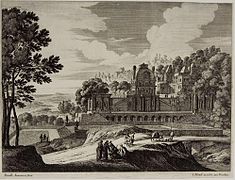
Grotto of Meudon in an imaginairy landscape, Harvard Art Museum, 34.1991 (The roofing of the central pavilion is fictive)
Château-Neuf (nový hrad)


We owe the plans of the Château-Neuf to the architect Jules Hardouin-Mansart. Philippe de Courcillon de Dangeau wrote May 21, 1706, that being at Marly, "the king worked in the morning with Mansart, who showed him the plans of the buildings that M. M. wants to make at Meudon at the place where the grotto is." Monseigneur wished this building to house the courtiers he received at Meudon, and the king aimed at the drawings made for Monseigneur. The building was erected on the site of the grotto, previously demolished in 1705.
A long corridor serves all the apartments: this was not unusual for the time. What was much more so was the systematization of the typical dwelling of the courtier, since the whole of the Château-Neuf can be compared to a "hotel" in the modern sense of the word.
After nearly two hundred years, a fire ravaged the building on January 31, 1871. The ruins were left to the inclement weather, and probably also looted, until 1879 when a law enacted the choice of Meudon as an observatory. Restoration of the ruins was then begun by the architect Neustálý Moyaux, saving from destruction what remained of the castle, especially the two lower floors, less damaged by the fire.

Château-Neuf from the parterre. Mariette, c. 1715

Third level of the Château-Neuf ("le bel étage"), by Mariette, around 1715
Cutaway of the Château-Neuf, circa 1720. Mariette

Levels 2 and 4 of the Château-Neuf. Mariette, c. 1715
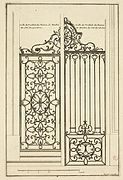
Grilles du Château-Neuf de Meudon. Mariette, A.F.

La grille basse du Château-Neuf, c. 1708 Musée-promenade de Marly-le-Roi.
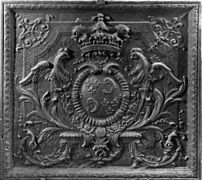
Taque foyère aux armes du dauphin, Château-Neuf, vers 1708. Musée d'art et d'histoire de Meudon
Photograph Château-Neuf, c 1860
Horní předsíň

The chateau was reached by the upper vestibule on the forest side. It was Italian, pierced by an opening, which made it possible to clear its space. The door-tops were carved with children representing the four seasons, the representation of which is preserved by photographs of plaster models, molded on the originals (Vente Sardou).
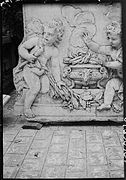
Winter, upper vestibule, 1708
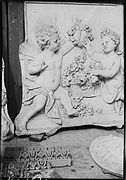
Spring, upper vestibule, 1708
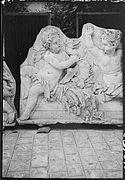
Summer, upper vestibule, 1708

Autumn, upper vestibule, 1708
Décor of the upper vestibule. Stockholm, NMH CC 1078
Pedestal of the vestibule. Stockholm, NMH CC 1073
Décor of the upper vestibule. Stockholm, NMH CC 1074
Detail of the cornice in the upper vestibule, National museum of Stockholm, NMH CC 1074
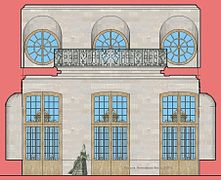
Cutaway of the upper vestibule, which functions as an Italianate salon
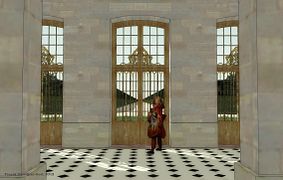
Reconstruction, seen from the upper vestibule
Příjem Louis já Portugalska podle Princ Napoleon, upper vestibule, 1867
Strážnice

This central room overlooked the flower beds through three rectangular windows (preserved bays). At its creation, it was lined with molded woodwork. On the mantelpiece was a copy of the David of Dominiquin. Louis XIV was particularly fond of this painting. Two paintings were ordered from the side exits: 1. a dog, and a greyhound, on the front in the middle of the game, scattered on the ground ducks partridges beccasses and hare in the middle A game-bag has a tree "; 2. a "hare that is attached to a tree by its left foot, on the left a dog at the feet of which are four partridges and a pheasant, on the front of the table a gun and its supply".

Cutaway of the guard room. Mariette. Shows positioning of the table of Desportes
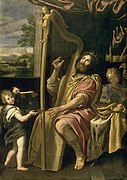
The Davide tím, že Domenichino, copy above the chimney
A sleeping dog, and a greyhound, François Desportes. 1709
A hare tied to a tree, François Desportes, 1709
První předpokoj

In 1775, the piece is described in the following way: "Antechamber or dining room in suitte. Room illuminated by two windows in the Levant, paneling of apui, cornice carved. Chimney of white marble vene (...) Two paintings above the doors, painted on canvas. One represents a golden vase, set on a marble pedestal, with a garland falling in festoons, and fruits. On the pedestal are limes, grenades and grapes, crimson curtain and sky background, the other represents a golden bronze vaze, surrounded by a garland of flowers posed on a fullte of green marble, beside is a vase Of silver overturned with a figure of a woman in the form of an anchor. These two paintings are from Fontenay ". The middle of the room is adorned with "a table of black mastic with flowers and birds in the natural".
Druhá předpokoj

When the Château-Neuf was finished in 1709, on avait disposé two paintings ordered from Fontenay, comme pour toutes les autres pièces de l'appartement, ce qui uniformisait le décor, à savoir :"A golden vase with two handles, surrounded by a garland of fruit, placed on a table of porphire, which is furnished with grapes; On the right, a basket filled with Italian grapes, cucumber, pomegranate and flowers; on the left, a crimson curtain, behind which are several golden basins, one of which is surrounded by a garland of flowers."
A pyramid of fruit resting on a marble table, on which is a melon hung next to a pomegranate; On the right, on the same table, an orange tree in a porcelain vase; On the same table, on the left, a large golden vase surrounded by a garland of flowers, at the foot of which is another silver vase reversed, a golden dish, a corner of which is hidden by a purple curtain of the same dimensions as the preceding.
The inventory of 1775 indicates that it is a:
"Room illuminated by a cross in the Levant, paneled high, scultée, gilded and varnished on wood, cornice in plaster scultée and gilded idem. The chimney of green-campan. (...) Two paintings above the doors, painted on canvases, each of width on height. The first one represents Apollo and Daphne, this god pursues this nymph who takes refuge in the arms of his father's river Peneus (mythology). The second represents the triumph of Acis a Galathea. The first of these paintings is by Antoine Coypel, druhý je Corneille (the elder)".

Apollo a Daphne, Antoine Coypel. Musée de Versailles
Acis and Galatée, Michel Corneille Musée de Versailles
Přehlídková komnata Monseigneur

The inventory of 1775 indicates for the parade chamber the following decoration:The room is illuminated by two windows on the east, wooden paneling, varnished and gilded on wood, sculpted and gilded římsa, large alcove supported on pilasters. Two paintings above the doors, painted on canvas, each 4 feet 9 inches wide by 3 feet 3 inches high. One represents a golden vase filled with different flowers, set on a marble ledge. In the background are two columns surrounded by garlands of flowers. The other represents a gold vase with a handle filled with different flowers, stoned on a stone fullteam, beside another vase. And on the other side a piece of drapery which falls on the edge of the full. These two paintings are by Fontenay. In this room is under the glass troughs two tables of green campan marble of long supported on feet consolle gilded and sculpted.
Originally, the alcove was decorated with the grotesque 12 months of Claude Audran III from the Gobelins, which still keeps nine of the twelve originals. The inventory of Crown furniture makes the following description:"A three-piece tapestry of low-woven tapestry, wool and evening, enhanced with gold and silver, manufactured in Paris, the Gobelins manufactory, the design by Audran, On twelve bands of daffodil, the divinities who preside at the twelve months of the year, under grotesque porticoes of different shapes, accompanied by the attributes of each divinity, grotesques, grooves and ornaments, with the sign of the month, separate daffodil bands By other narrower stripes, with a purple background, laden with mosaics, and the figures of Louis Francie, all of silver, the top and bottom borders like the bands Narrow, with silver shells and dolphins, the curtain containing 9 aunes 1/8 of course on 3 aunes ¼ high, made expressly for the chamber of Monseigneur, in his apartment of the new castle in Meudon."
Here is the list of the gods attached to the months grotesky:
- "January under the protection of Juno "
- "February under the protection of Neptune "
- "March under the protection of the god Mars a Minerva "
- "April under the protection of Venuše "
- "May under the protection of Apollo "
- "June under the protection of Rtuť "
- "July under the protection of Jupiter "
- "August under the protection of Ceres "
- "September under the protection of Vulcan "
- "October under the protection of Minerva a Mars "
- "November under the protection of Diane "
- "December under the protection of Vesta "

Coupe of the parade chamber in the Château-Neuf of Meudon, circa 1709
Elévation du fond de la chambre de parade, circa 1708, with the bed
Six des douze mois grotesques, de Claude Audran III, copy of the panneaux pour la tenture réalisée for Meudon. Sotheby's, 18 November 2010, New-York, lot 235

Design of the chamber woodwork. Nationalmuseum, Stockholm, NMH CC 2300
Projet (ultérieur ?) de décor pour l'alcôve (non Versailles), BNF
Balustrade in gilded wood from the parade chamber, circa 1708
Galerie

Cross-section of half the gallery of Monseigneur at the Château-Neuf in Meudon, condition in 1709. Nationalmuseum de Stockholm
Cross-section of half the gallery. Stockholm, NMH THC 5953
Plan of half the gallery, Stockholm, NMH THC 5954
Schéma de l'élévation de la galerie, Stockholm NMH CC 2855
Details of the cheminée et des consoles NMH CC 1105

Cyrus interrogeant le roi d'Arménie (Cyrus questioning the king of Armenia), Noël Coypel. Muzeum v Grenoblu

Néron au milieu d'un festin ordonnant la mort d'Agrippin (Nero in the midst of a Feast Ordering the Death of Agippinus), Noël Coypel. Muzeum v Grenoblu
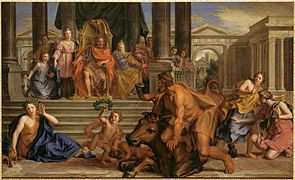
Herkules and Archélaos, Noël Coypel. Musée de Versailles

Herkules a Déjanire, Noël Coypel. Musée de Versailles

Orangeries
In order to protect the orange trees from the cold during the winter, two main orangeries were built at Meudon, the most important of which is the Château-Vieux.
Oranžerie starého hradu
Traditionally, in French castles since the 18th century, an orangery is both a utilitarian building and a strong element of the monumental composition constituted here by the terrace, the Castle-Vieux and the loggia. Its dimensions determine the magnitude of the great perspective that extends from the castle to the plateau of Villacoublay.
The orangery was probably built between 1655 and 1659 by the architect Louis Le Vau, for owner of the estate Abel Servien, superintendent of finance under Louis XIV. Open to the south though eight high windows on either side of a monumental entrance, the orangery is intended to house the park's orange trees during the cold season. During the summer, orange trees were displayed on its floor around a rectangular basin, as well as on the grounds of the castle and cave. The orangery extends eastward with a bastion in coarse apparatus.
Renovated several times in the 19th century, then abandoned until 1980, the parterre of the orangery was restored between 1980 and 1984, to its 17th-century appearance.
L'orangerie of Meudon, 17th century. Restored in 2012
The nymphaeum above the orangery
Orangery of Meudon before restoration, 2010
Inside the bastion of the orangery, 2014
Oranžerie nového hradu
It was built at the same time as the Château-Neuf, between 1706 and 1708. It was demolished during the reign of Louis XVI.
Orangery of the Château-Neuf
Interior of Orangery, Château-Neuf
Skleník pod Orangerie du Château-Vieux
A third building was used for the conservation of shrubs during the winter. The "greenhouse" was located immediately below the bastion of the Orangery of the old castle in Meudon. There is still the wall at the bottom, enclosed, as well as a buttress. The rest of this building adjoins the back of the garden of the Museum of Art and History of Meudon.
Stáje


The new commons still exist today, perfectly preserved. They are located at the entrance of the estate, at the top of the avenue to the castle.They were built by extending an earlier building, the chovatelská stanice of Louvois.
The three inner courtyards connect through a clear central passage for horses. The stables have only one floor, attic, so as not to obstruct the view of Paris from the Pond of Bel Air above. Abundant dwellings for the castle staff furnish this floor.
All the stalls were rebuilt in the 19th century. Some still exist.
Today all of these buildings are assigned to the Observatoire de Paris, which prevents access to all visitors.The commons have a total area of 5,000 m² (2,500 m² on each of the two levels).To this must be added also the area of the adjoining guard-house, of 850 m².
Zahrady

The gardens of Meudon were of great magnificence. There were high gardens and low gardens, not to mention the Grande Perspective. The Meudon Way describes the itinerary for discovering Meudon's points of view at the end of the reign of Louis XIV. They are classified as "slope gardens".
Velká perspektiva



The Great Perspective is the monumental axis that organizes all the area of Meudon. It is perfectly rectilinear over a distance of 3.5 km, despite the unevenness of the terrain. It was created on both sides of the Château-Vieux, a place occupied from the beginning.
At its apogee, at the beginning of the eighteenth century, it was composed as follows (from north to south):
- Avenue du château (planted with four rows of trees)
- First ditches
- Front yard (on the right, terrace of the chestnut trees)
- Second ditches (buried under the terrace)
- Courtyard of the Château-Vieux, known as the royal court
- The Château-Vieux (destroyed, cellars preserved)
- The floor, designed by André Le Nôtre (zničeno)
- The Orangerie, of Louis Le Vau, with a circular basin
- The parterre of the Orangerie, with a rectangular basin
- Lawn, with a white marble statue, unidentified
- The basin known as the "Grand Carré" (destroyed)
- New lawn, shorter than first
- The water grid, with 10 jets of water (destroyed)
- Other lawn, longer
- The pond of Chalais (on the right, the carp channel)
- The Green Carpet
- The pavilion of Trivaux (under Louis XVI) (destroyed)
The axis ended at an alley drawn on the plateau of Trivaux.

Estampe d'Israël Silvestre représentant la Grande Perspective de Meudon depuis le tapis vert. Vers 1685.

Vue aérienne de la Grande Perspective de Meudon.

Vue aérienne par drône de l'avenue du château, en direction du nord.
Schéma de la Grande Perspective de Meudon, 2015. Légende : 1.Avenue du château ; 2.Grande Terrasse du château ; 3. Orangerie ; 4.Partie toujours bouchée ; 5.Étang de Chalais ; 6.Tapis Vert.
Nízké zahrady

They were mainly developed by Louvois, and then embellished by Monseigneur and Louis XIV. Their difference in level and the different points of view made the charm, as well as the presence of many water bodies and thousands of topiaries. It was accessed from the "Grand Carré" basin:
- The floor of the Oval;
- On the left, the channel of the shadow;
- On the right, the half-moon;
- The wood of Guenegaud, with its pavilion;
- The basin of the octagon;
- Below, the "play of M. Le Nostre", framed by two cascades;
- In the background, the vertugadin, going up.
- On the left, Cleopatra's grove;
- The Arthelon canal
- The Arthelon waterfall
- The chestnut grove
- The Small Grotto of the Hotel Courtin
- The parterre of the Hôtel Courtin
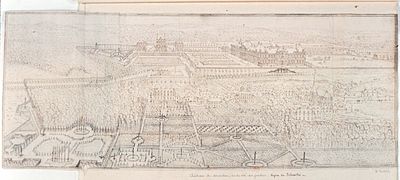
Les jardins bas de Meudon (The Low Gardens of Meudon), by Izrael Silvestre, 17th century, BNF
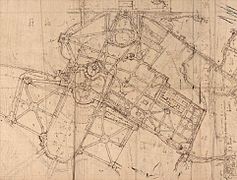
Detail of the low gardens on the draft plan for the gardens at Meudon. ADY (78). Circa 1697

Le bassin de l'Ovale, jardins bas de Meudon. Circa 1690
"Meudon. Les 2 châteaux réunis sous un même aspect", drawing by Jean-Baptiste Maréchal, 1785. View from the Ovale

Restitution 3D des jardins bas, avec la "pièce de M. Le Nostre". Condition circa 1700
Vysoké zahrady

The area of the high gardens is nearly three times larger than that of the low gardens. The hold of these high gardens is still preserved today, occupied mainly by the Pařížská observatoř. The gardens consisted of a labyrinthine network of walkways, embellished with numerous pieces of water. Unlike the low gardens, the high gardens were mainly flat, since organized on the hill of Meudon. There were:
- The parterre of the Grotto, then parterre of the Château-Neuf in 1708
- The Cradles, simplified in 1708
- The floor of the Globe
- The parterre des Bois
- The Calotte
- Slunečník
- Gladiátor
- The Grove of the Cloisters
- The Bel Air Basin
- The gardens of Montafilan, with the stone cabinet
- The bastion of the Capuchins, which served as a point of view on Paris and Saint-Cloud.
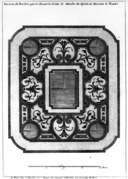
The parterre of the Grotto, engraved by Mariette
Quarter of the parterre of the Grotto. Nationalmuseum of Stockholm. Condition of parterre between 1680 and 1708
Recreated view from the "Parasol", circa 1700
South semi-circle of the Bel Air basin, 2010

Elévation du cabinet de pierre des jardins hauts de Meudon, du côté de Montafilan (près des Capucins). Nationalmuseum de Stockholm, NMH THC 377.

View from the bastion of the Capucins, Jacques Rigaud, circa 1730
Park a rybníky

The park of Meudon extended as far as Chaville, and thence reached that of Versailles. The elevation of the terrain, the dense forest, the numerous ponds, the great plains situated on the heights are the main features of this park in the 17th and 18th centuries. Mezi ně patří:
- The pond of the Garenne
- The Triveau pond
- The pond of the Fountains
- The pond of Vilbon
- The Renault Fosse pond
- The Tronchet pond
- The old tank
- The new tank
- The leg of Oye
- The farm of Vilbon, with the mills for the waters.
Note that the pond called Meudon was not created until the 20th century.
The historical library of the city of Versailles preserves a manuscript of the reservoirs of Meudon, with the arms of the Grand Dauphin, dating about 1700.
- Plans des réservoirs et étangs qui sont à Meudon, Bibliothèque historique de Versailles.

Binding with the arms of the dauphin

Titulní strana

Villacouplay pond

Tronchet pond

Villebon pond

New reservoir

Old reservoir

Bel air

Pond of the fonceaux

Pond of the garenne

Pond of Triveau

Trout canal

Pond of Chalais

Etang du loup pendu

the different levels

(suite)

(suite)

(suite)

(suite)

Binding with arms
Vesnice Meudon


The village of Meudon was made up of numerous hotels and properties, the most important of which belonged to characters linked to the owners of the castle. Mezi ně patří:
- Saint Martin's Church, (preserved)
- Hotel Henri du Plessis-Guénégaud (zničeno)
- Hotel Bellon, (destroyed)
- Hotel Richer, (preserved)
- Hotel Tourmont, (preserved)
- The hotel of the Countess of Verrue (zachováno)
- The castle of Fleury (destroyed)
- The country house of Mmě de La Fayette in Fleury
- The folly of Jean-Jacques Huvé, (preserved)
- The villa of Jean-François Jacqueminot
- The Gallyot hotel in Fleury, (destroyed)
- Dům Pierre-Joseph Redouté
- The house of Bastide, then house of Bailly. (Zničeno)
- Klášter Menší bratři kapucíni, the first of this order installed in France by the care of the Cardinal of Lorraine
All these buildings and gardens were visible from the castle or its gardens.
Reference
- ^ Sometimes written "Ysbarre"
- ^ http://www.persee.fr/web/revues/home/prescript/article/bec_0373-6237_1927_num_88_1_452416
- ^ Mirot, Léon (1927). "Études Lucquoises". Bibliothèque de l'École des Chartes. 88: 275–314. doi:10.3406/bec.1927.452416.
- ^ http://parismoyenage.fr/parisiens/nom_p.php?search=Isbarre&nom=Isbarre&prenom=Augustin
- ^ Carroll 2009, str. 88-89.
- ^ http://dumas.ccsd.cnrs.fr/dumas-01092058/document
- ^ Le Chant Pastoral de Ronsard évoquant la Grotte de Meudon.
- ^ See Memorial of 27 July 1618, AN, MC, XXIV, 132
- ^ https://www.louvre.fr/en/oeuvre-notices/mercury-abducting-psyche
- ^ Internet Archive - LE SIÈCLE DES BEAUX ARTS ET DE LA GLOIRE ou LA MÉMOIRE DE LOUIS XIV JUSTIFIÉE DES REPROCHES ODIEUX DE SES DÉTRACTEURS OUVRAGE OU SONT PASSÉS EN REVUE LES PRINCIPAUX AUTEURS QUI ONT ÉCRIT SUR LE RÈGNE BU GRAND ROI DEPUIS 1715 JUSQU'À NOS JOURS - ANCIEN SECRÉTAIRE DES ARCHIVES DE LA COURONNE - VERSAILLES CHEZ DUFAURE IMPRIMEUR RUE DE LA PAROISSE 21 - 1838
- ^ https://gallica.bnf.fr/ark:/12148/btv1b530874353.r=chateau+de+petit+bourg.langFR
- ^ The day after the feasts of Pentecost (the day of the arrest of Voltaire ), the Czar passed through Les Invalides on the way back from the château de Meudon, where he was said to have desired to take saddle, and being on a pierced chair, asked for paper from the valet who had brought it to him; the latter having none to give him, the prince used an ecu of one hundred sols instead, presenting it afterwards to the valet, who declined it saying that the recepční had forbidden him from accepting anything from anyone; on seeing which the Czar, after having told him several times to take it, threw him, full of villainy to the ground. The recepční, having heard the account of the valet, told him laughing aloud: "Go on, go, when you will have washed this écu, it will be as good as any other: I am confident that you lacked paper in order to profit from this écu, to give yourself the means to drink to the health of the prince with your comrades." Journal de la Régence, Jean Buvat, 17 May 1717
- ^ Michelet (Histoire de France, volume 17, Lacroix & Co., 1877, p. 155) suggests that the Regent ceded the castle of Meudon to his daughter on learning she was pregnant: a prolonged stay at Meudon would allow the young widow to wait out this new pregnancy and give birth with discretion, away from the prying eyes of courtiers and gossipmongers.
- ^ The Regent's strategy failed: even in the final months of her pregnancy, the Duchess did not give up her daily rounds of entertainments and sensual debauchery, overindulging in copious suppers washed down with much wine and liquor. On 28 March, her labor pains began at her Palais du Luxembourg, allegedly after a carnal night of pleasure and heavy drinking. Ill-prepared by her licentious lifestyle, she found her labour harrowing and lengthy. Saint-Simon sarcastically describes this perilous childbirth, which provoked a great scandal and was seen as divine punishment for Berry's very sinful life. It seems that she went into preeklampsie and seemed about to die. The Abbé Languet de Gercy, parish priest of Saint-Sulpice, refused to administer the Holy sacraments. On April 2, Berry delivered a stillborn child, and was thus relieved of her "dangerous indigestion" (as the official version of her "illness" put it).
- ^ According to Saint-Simon (Mémoires(Memoirs) VII, 456) the autopsy found that "the poor princess was pregnant". As Duclos remarked (Œuvres complètes (Complete Works), 1821, Vol.6, p.369) "she wasted no time after giving birth". The "fertile Berry" (one of her sobriquets in the satirical poems embroidering her illegitimate pregnancies) apparently again became pregnant during her convalescence at Meudon, the month following her very arduous labor at the Luxembourg.
- ^ http://chateau-meudon.wifeo.com/stanislas-a-meudon.php
- ^ https://www.musee-lorrain.nancy.fr/fr/la-lorraine-pour-horizon/catalogue-numerique/declaration-de-meudon-109
- ^ Frédéric d’Agay (éd.), Journal de voyage de l’abbé Cavalier de Fréjus à Paris et Versailles (février-juin 1748). Unpublished annotated document online at CourdeFrance.fr, 1 September 2008 (http://cour-de-france.fr/article497.html )
- ^ Inventory preserved in the INHA library, carton 46, file XII, microfilm 24170-24198
- ^ "Les collections du département des arts graphiques - Retour de la promenade de Mr le Dauphin au vieux château de Meudon - ISABEY Jean-Baptiste".
- ^ Emile Dard (1905). Perrin et cie (ed.). Le général Choderlos de Laclos, auteur des liaisons dangereuses, 1741-1803 [General Choderlos de Laclos, author of Liaisons dangeureses 1741-1803] (francouzsky). Paříž. p. 516.
- ^ http://restaurermeudon.wifeo.com/images/p/pot/potentiel-archeologique-meudon-oct-2012.jpg
Zdroje
- Carroll, Stuart (2009). Martyrs and Murderers, The Guise Family and the Making of Europe. Oxford University Press.CS1 maint: ref = harv (odkaz)
- Fiske Kimball, Stvoření rokoka, (Philadelphia Museum of Art) 1943.
externí odkazy
- The Web page about the "Château de Meudon" (francouzsky)
- Châteaux de Meudon (francouzsky)
- Engravings of the Château de Meudon.
- Construction of the Observatoire de Paris at Meudon. (francouzsky)






























